Coronavirus (COVID-19) business support measures: evaluation
This evaluation assesses the outputs and indicative outcomes of the COVID-19 business support measures available in Scotland up to summer 2021.
Annex 1: Scheme by Scheme Management Information Data
This annex provides the management information data from each scheme to show the numbers of businesses applying for and receiving support from each scheme, alongside the value of support provided, with breakdowns by sector and geography where possible.
i. UK Government Schemes
Coronavirus Job Retention Scheme (CJRS)
- What is it? Allows UK employers to claim a grant to cover 80% of the wage costs for those employees furloughed due to COVID-19, subject to a monthly cap of £2,500. Employees can now be on full-time or flexible furlough. From 1 July 2021, the level of grant will be reduced and businesses will be asked to contribute towards the cost of their employees' wages.
- Value: £65.9 billion across UK up to 14 June 2021 (Scotland data not available)
- Take up: 906,400 jobs furloughed in Scotland.
- Status: Scheme still open. It has been extended until 30 September 2021.
In Scotland, 906,400 cumulative jobs had been furloughed as at 14 June 2021, accounting for 7.8% of UK total (11.6 million), in line with Scotland's share of total UK employees.[68]
Provisional figures from a snapshot as at 31 May 2021 show:
The take-up rate (furloughed staff as a proportion of eligible employments) stood at 7% in Scotland, in line with Wales, but below the take-up rates for England and Northern Ireland (both 8%). The take-up rate in Scotland has decreased from 12% at the end of April 2021 (number of employments furloughed decreased from the end of April to the end of May by around 103,000).
In Scotland, 173,100 employments were furloughed (both full and partial), while the equivalent figure for the UK was 2.4 million. 51.9% (89,900) furloughed employments in Scotland were on flexible furlough with the remaining 48.1% (83,300) fully furloughed as at 31st May 2021. The proportion of furloughed employments that were fully furloughed in Scotland (48.1%) was lower than in England (52.3%) and Northern Ireland (51.9%) but higher than in Wales (45.0%).
Between the start of the time series for Scotland on the 1 July 2020 and 1 November 2020 there was a downward trend falling from 421,200 on 31 July 2020 to 228,300 on the 30 November 2020. The number of employments on furlough increased again to a peak 393,400 on 19 January 2021, decreasing to 173,100 on 31 May 2021.
| Date | Scotland | UK | |
|---|---|---|---|
| Employments furloughed in Scotland | Take-up rate (% of eligible employments) | Take-up rate (% of eligible employments) | |
| 31 July 2020 | 421,200 | 17% | 18% |
| 31 August 2020 | 286,900 | 12% | 13% |
| 30 September 2020 | 216,500 | 9% | 9% |
| 31 October 2020 | 195,200 | 8% | 8% |
| 30 November 2020 | 228,300 | 10% | 13% |
| 31 December 2020 | 288,900 | 12% | 14% |
| 31 January 2021 | 373,000 | 16% | 17% |
| 28 February 2021 | 368,400 | 16% | 16% |
| 31 March 2021 | 333,400 | 14% | 15% |
| 30 April 2021 | 275,700 | 12% | 12% |
| 31/05/2021p | 173,100 | 7% | 8% |
Source: Coronavirus Job Retention Scheme, HMRC
p – data for 31 May 2021 is provisional
The take-up rate of employments furloughed varied across Scotland ranging from 5% to 9%. By Scottish local authority (LA), South Ayrshire, Highland, Glasgow and Edinburgh had the highest take-up rates (all 9%).
Looking at the urban/rural split, 29% of employees furloughed in Scotland were in LAs classed as rural while 71% were in LAs classed as urban, broadly in line with the proportion of Scottish employment in each area. The take-up rate was 7% in rural LAs and 8% in urban.
By sector, in Scotland, the highest take-up rate was in the Accommodation and food services (32%, 45,900 employments on furlough), followed by Arts, Entertainment and Recreation (27%, 13,000), and Other Service Activities (19%, 7,100). For the UK as whole, the take-up rates were highest in the same sectors. Across all Scottish Local Authorities, the highest number of employments furloughed were in the Accommodation and food services sector.
By gender, the take-up rate was slightly higher for men (8%) than women (7%) in the Scotland, whereas take-up rates for men and women were the same for the UK (8%). It is estimated that 86,300 women were in receipt of furlough compared to 86,900 men. Compared with the other UK countries, the take-up rate for women in Scotland (7%) was the same as Wales and Northern Ireland but slightly lower than England (8%).
Data on take-up by business size band and age is currently only available at the UK level. By business size band, across the UK a whole, 39% of jobs furloughed were in micro firms, 25% in small, 13% in medium and 23% in large firms.
The take-up rate was higher for the younger age groups of Under 18 (13%) and 18-24 (10%) year olds compared to the UK average (8%). Those aged 65 and over were also more likely to be on furlough (12% take-up rate).
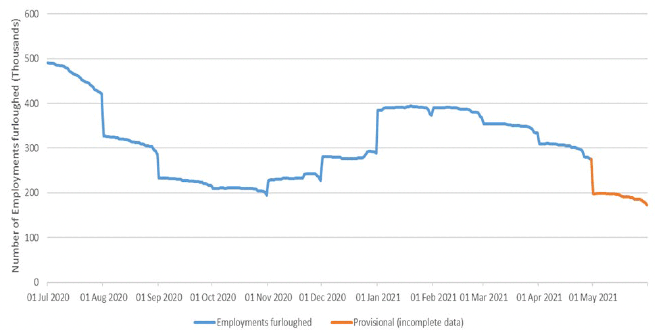
Source: HMRC
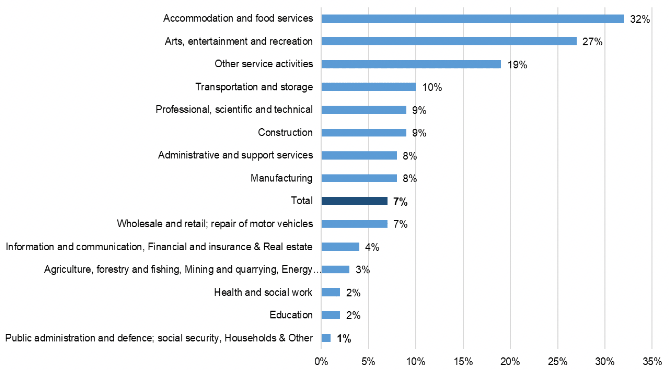
Source: HMRC , claims as at 31st May 2021
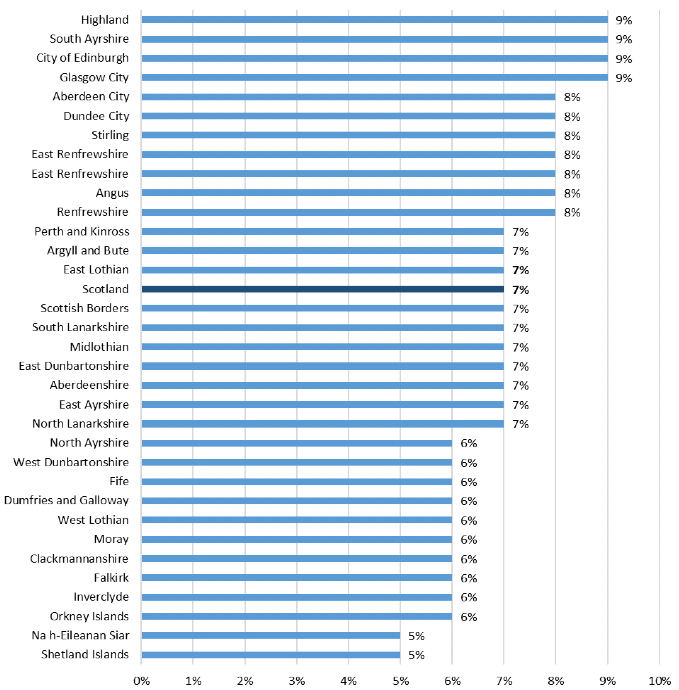
Source: HMRC, claims as at 31st May 2021
Self-Employment Income Support Scheme (SEISS)[69]
- What is it? A grant for the self-employed in the UK that have been adversely affected by Covid-19 worth 80% of their average monthly trading profits, paid in a single instalment covering three months' worth of profits, and capped at £7,500. Since its inception there have been four rounds of the SEISS grant. To be eligible, individuals have to earn the majority of their income from self-employment and have to earn less than £50,000.
- Value: £1.5 billion in Scotland.
- Take-up: 553,000 self-employed individuals supported in Scotland
- Status: First four grants now closed. Fifth grant open for claims from late July 2021.
Statistics for Scotland show that across the four grants up to 6th June 2021, 553,000 claims have been made and £1.5 billion has been paid in SEISS grants in total. 174,000 unique individuals have received a grant to date.
The statistics below relate to claims to the fourth SEISS grant made up to 9th May 2021:
In Scotland, 120,000 out of an eligible 207,000 self-employed individuals made a claim in the fourth round of SEISS, representing a 58% take-up rate, in line with the UK as a whole. The total value of claims was £337 million with the average claim value being £2,800 (the same as the UK). Scotland accounted for 6% of all UK claims (1.95 million), reflecting the relatively lower level of self-employment in Scotland.
By local authority, the highest take-up rate was in West Dunbartonshire (68%), North Lanarkshire and Glasgow (both 65%) and the lowest was recorded in Orkney Islands (35%). Total value of claims were highest in Glasgow City (£36.7 million) and the City of Edinburgh (£34.4 million). The average claim value ranged from £2,500 in Dundee City and Inverclyde to £3,300 for the Shetland Islands.
By urban/rural classification, the take-up rate in LAs classed as rural (51%) was lower than that in LAs classed as urban (62%). 33% of claims in Scotland were in LAs classed as rural while 67% were in LAs classed as urban.
By sector, the highest take-up rate was highest in the Other service activities (includes hairdressing, beauty) (76%) and Transport and Storage (75%) sectors and the lowest was in Agriculture, forestry and fishing (21%). Construction received the greatest proportion of the total value of claims in Scotland (32%).
By gender, a slightly lower proportion of eligible females claimed (56%) compared to males (59%). The average claim for females was also lower at £2,300 compared to £3,100 for males. For both men and women, the value of claims was lowest for young workers (16-24 years) and the take-up rate was lowest for those aged 65 and over. For men, the take-up rate was highest for 35-44 year olds (63%) and for women the take-up rate was highest for 25-34 and 35-44 year olds (both 59%). The average value of claims made by men was highest in the 35-44, 45-54 and 65+ age groups (£3,200) while the average value of claims made by women was highest for 65 years and above (£2,900).
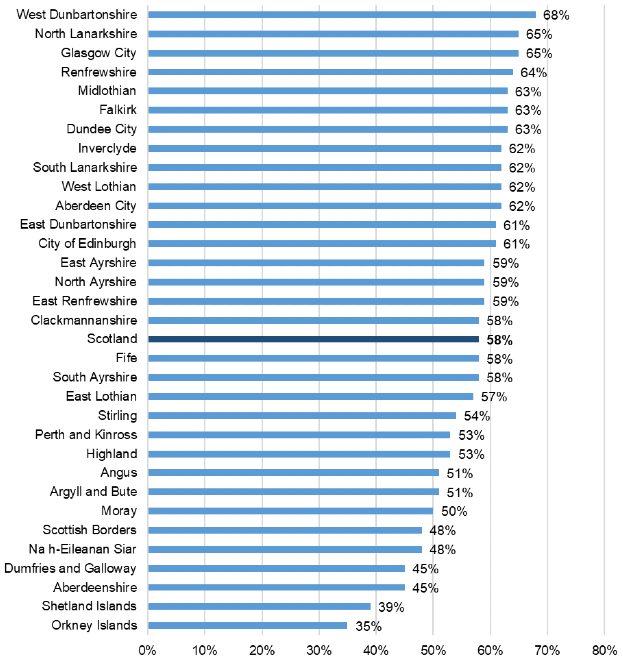
Source: HMRC
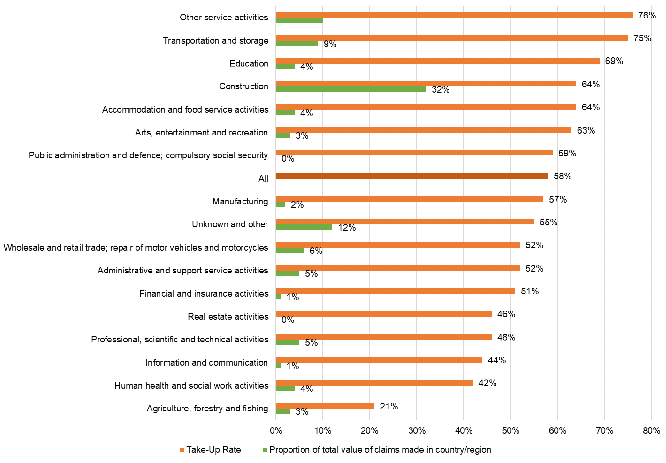
Source: HMRC
UK Government Loan Schemes[70]
- What is it? Loans and other finance facilities (including overdrafts, invoice and asset finance) designed to support UK businesses that are losing revenue and seeing their cash flow disrupted as a result of COVID-19. They comprise:
- (a) Bounce Back Loan Scheme (BBLS) – loans for SMEs requiring between £2,000 and 25% of their turnover, to a maximum of £50,000. UK Government guarantees 100% of the finance to the lender and pays interest and any fees for the first 12 months. Fixed interest rate of 2.5% thereafter. Businesses had the opportunity top up existing loans to max amount and covert to BBLS from CBILS/CLBILS/CCFF once it opened.
- (b) Coronavirus Business Interruption Loan Scheme (CBILS) – for smaller businesses (with annual turnover up to £45m) requiring up to £5m in finance. UK Government guarantees 80% of the finance to the lender and pays interest and any fees for the first 12 months. Interest thereafter varies by lender.
- (c) Coronavirus Large Business Interruption Loan Scheme (CLBILS) – for larger businesses (annual turnover over £45m) requiring up to £200m in finance. UK Government guarantees 80% of the finance to the lender. Interest thereafter varies by lender. (Data for Scotland not available)
- Value: £79.31 billion across UK
- Take-up: 1,670,939 businesses supported across UK
- Status: Schemes closed 31 March 2021.
Take-up (number of approved loans) and value data for Scotland is available for CBILS and BBLS, but is not yet available for CLBILS due to data protection and commercial considerations. It is unclear if or when disaggregated CLBILS data for Scotland will become available.
Data on application success rates for each scheme is available only for the UK as a whole.[71] Success rates for businesses across the UK as a whole vary considerably across the three schemes, with BBLS having a significantly higher application success rate (74%) than CBILS (44%) or CLBILS (65%). (Table A2)
BBLS was the most popular of the three schemes, accounting for 89% of the total number of applications across the UK, reflecting its eligibility to SMEs which account for the majority of businesses in the UK. It also provided the greatest proportion of support of all three schemes, accounting for 93% of the total number of approvals and 60% of the total value of approvals across all three schemes.
CLBILS accounted for just 0.05% of applications and 0.05% of approvals across all three schemes, reflecting its eligibility to businesses with turnover above £45m which account for just 2% of registered employers in Scotland and 1% across the UK as a whole.
| BBLS | CBILS | CLBILS | Total | |
|---|---|---|---|---|
| Number of formal applications | 2,094,858 | 251,342 | 1,152 | 2,347,352 |
| Number of approvals | 1,560,309 | 109,877 | 753 | 1,670,939 |
| Value of approvals (£bn) | £47.36 | £26.39 | £5.56 | £79.31 |
| Application success rate | 74% | 44% | 65% | - |
| Average (mean) loan amount (£m) | £0.030 | £0.240 | £7.384 | - |
| Proportion of total number of applications | 89% | 11% | 0.05% | - |
| Proportion of total number of approvals | 93% | 7% | 0.05% | - |
| Proportion of total approvals value | 60% | 33% | 7% | - |
Source: UK Treasury
(a) Bounce Back Loan Scheme (BBLS)[72]
86,062 loans worth £2.496 billon have been offered to businesses in Scotland under BBLS. Scotland's share of value of overall BBLS support (6%) is in line with Scotland's share of the business base (6%). It could therefore be deemed that Scottish businesses have succeeded in securing a fair proportion of these loans, provided by the UK Government.
Data on the number of formal applications is not available for Scotland, therefore it is not possible to calculate the provisional application success rate and compare with the UK as a whole (74%). The average (mean) loan amount for Scotland (£29,000) is broadly in line with the UK as a whole (£30,000).
Data on take-up by sector is available only at the UK level. 'Construction' had the greatest share of BBLS facilities approved (17%), in line with the sector's proportion of the UK business population (17%). This was followed by the 'Wholesale and Retail Trade' sector (15%) which received a greater share of facilities than the sector's proportion of the UK business population (9%). (Chart A6)
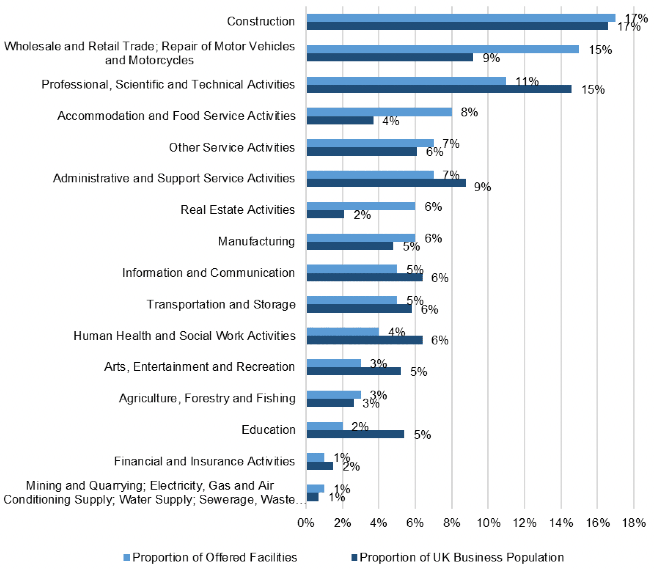
Source: British Business Bank
(b) Coronavirus Business Interruption Loan Scheme (CBILS)[73]
4,144 loans worth £982.517 million have been offered to businesses in Scotland under CBILS. Scotland's share of value of overall CBILS support (6%) is in line with Scotland's share of the business base (6%). It could therefore be deemed that Scottish businesses have succeeded in securing a fair proportion of these loans, provided by the UK Government.
Data on the number of formal applications is not available for Scotland, therefore it is not possible to calculate the provisional application success rate and compare with the UK as a whole (42%). The average (mean) loan amount for Scotland (£237,000) is in line with the UK as a whole.
Data on take-up by sector is available only at the UK level. 'Wholesale and Retail Trade' had the greatest share of CBILS facilities approved (18%) despite only representing 9% of the UK business population. This was followed by the 'Construction' (14%), 'Manufacturing' (13%), and 'Administrative and Support Service Activities' (11%) sectors. (Table A7)
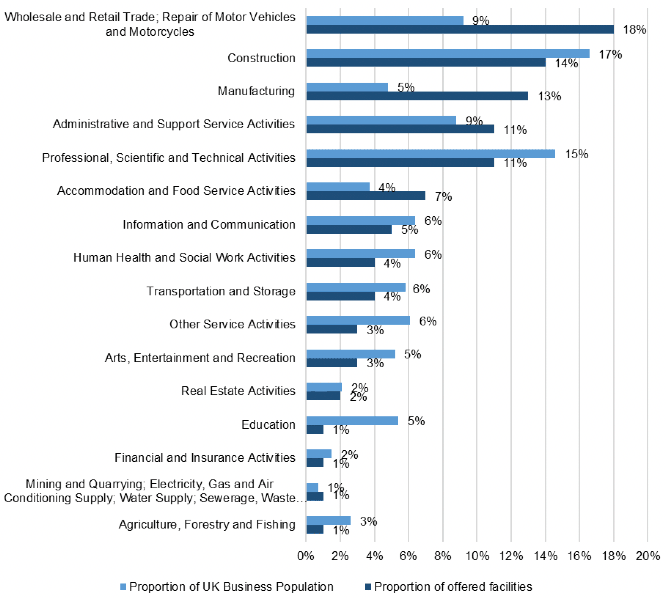
Source: British Business Bank
Future Fund[74]
- What is it? Convertible loans between £125,000 and £5m for pre-revenue or pre-profit innovative UK businesses that typically rely on equity investment and are affected by the COVID-19 pandemic. Subject to at least equal match funding from private investors.
- Value: £8.6 million in Scotland
- Take-up: 22 business supported in Scotland
- Status: Scheme opened 20 May 2020 and closed 31 January 2021.
In Scotland, 22 convertible loans had been approved as at 21 March 2021, worth £8.6 million, accounting for 0.7% of the UK total by value (£1.2 billion to 1,236 businesses). London accounted for nearly two-thirds (60%) the value and the South East for a further 12%. These proportions are broadly in-line with the wider market trends for the distribution of equity investment across the UK.[75]
The average loan amount was significantly lower in Scotland (£0.39 million) than in the UK as a whole (£0.97 million). Scotland reported the lowest average loan amount and share of total value of loans approved out of all the UK regions.
The application success rate across the UK as whole stood at 52% as at 21 February 2021.
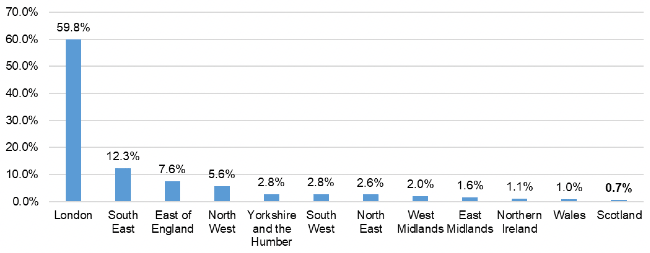
Source: HM Treasury
Data on application success rate and breakdowns by gender and ethnicity of management teams is only available at the UK level.
77% of the total value of loans approved in the UK as a whole went to companies with mixed gender management teams. Only 1% of funding went to all female management team businesses (Chart A9). For context, in 2019, 15% of small to medium-sized enterprises in the UK were women-led.
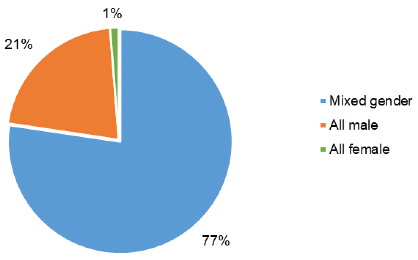
Source: HM Treasury
56% went to businesses with mixed ethnicity management teams, 38% went to all White management team businesses and 5% went to sole ethnic minority management team businesses. (Chart A10)
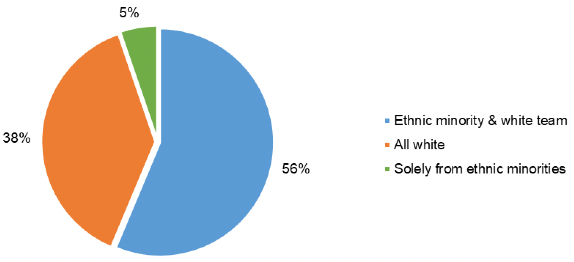
Source: HM Treasury
COVID Corporate Financing Facility (CCFF)[76]
- What is it? Designed to support liquidity among larger UK firms, helping them to bridge coronavirus disruption to their cash flows through the purchase of short-term debt in the form of commercial paper (CP).
- Value: £600 million of CP, net of redemptions, purchased in Scotland
- Take-up: 2 businesses in Scotland have outstanding CP under the scheme.
- Status: Scheme closed to new applications on 31 December 2020.
As at 30 June 2021, 21 businesses across the UK had issued CP under the scheme. In total, the value of CP held by the CCFF for the 21 businesses stood at £4,408 billion. The value of CP for each business ranged from £5 million to £600 million, with an average of £211 million across all 21 businesses.
A list of the businesses supported by the scheme is publically available. OCEA have matched the list of businesses as at 30 June to the FAME database to determine the sector and country where they are registered.
Just two of the businesses (First Group plc and Stagecoach Group plc), both of which are in the transportation and storage sector, were registered in Scotland. The value of CP held by the CCFF for these two businesses was £600m (£300m each), accounting for 14% of the UK total by value of CP.
The majority (71%) of business supported by the scheme were registered in England and accounted for 53% of the value of CP held by the scheme (Chart A11).
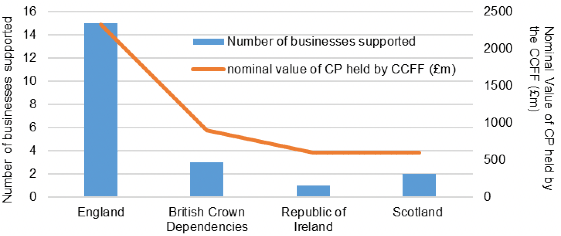
Source: Bank of England and FAME
Eat Out to Help Out Scheme[77]
- What is it? Scheme enabled restaurants, cafés, pubs and other eligible establishments such as workplace and school canteens to offer a discount to customers dining in their outlet and obtain a reimbursement from HMRC for the same amount. The scheme offered a 50% discount on the purchase of food and non-alcoholic drinks bought to eat in, up to a maximum of £10 per person. The discount did not apply to takeaway food. The discount was available all day every Monday, Tuesday and Wednesday between 3 and 31 August.
- Value: £42.195 million discount claimed in Scotland.
- Take-up: 4,775 restaurant establishments claimed.
- Status: Scheme closed 31st August 2020.
In Scotland, the total amount of discount claimed through the scheme was £42.915 million, accounting for 7% of the UK total by value (£611.67 million). 4,775 restaurants with less than 25 outlets participated in the scheme in Scotland claiming a total of 7,235,000 meals.
The majority (84.3%) of participating outlets were located in England. The remaining outlets were split between Scotland (8.0%), Wales (4.5%), and Northern Ireland (3.0%). These proportions are not significantly different from the share of the population in each country.
The average amount claimed per outlet in Scotland was £9,000, slightly lower than the UK average of £10,198. The average discount per meal was, however, slightly higher in Scotland than the UK (£5.93 vs £5.74).
By local authority, Edinburgh had the greatest share of restaurants making claims under the scheme in Scotland for which data were available (15%). However, Glasgow had the largest share of meals claimed for (17%) and share of discount claimed (18%) for the scheme in Scotland. In terms of numbers of meals claimed for, Glasgow ranked 7th of 379 UK Local Authorities, while Edinburgh ranked 11th. South Ayrshire (£13,100) and West Dunbartonshire (£12,800) reported the highest average amount claimed per outlet while Aberdeen City (£3,000) reported the lowest. By average discount per meal, Argyll and Bute (£6.86) and City of Edinburgh (£6.70) reported the highest while West Lothian (£4.59) had the lowest.
By parliamentary constituency, Glasgow Central (8%) had the greatest share of restaurants participating in the scheme in Scotland with 382 restaurants claiming 0.7 million meals. This was followed by Edinburgh North and Leith (5.5%, 265 restaurants, 0.3m meals). By share of amount of discount claimed, Glasgow Central (11%) had the greatest share with a total of £4.8 million discount claimed. This was also followed by Edinburgh North and Leith (5%, £2.2m). The average discount per meal was highest in Aberdeen South at £7.69 compared to an average of £5.93 for Scotland. Average discount per meal was lowest in Aberdeen North at £3.39.
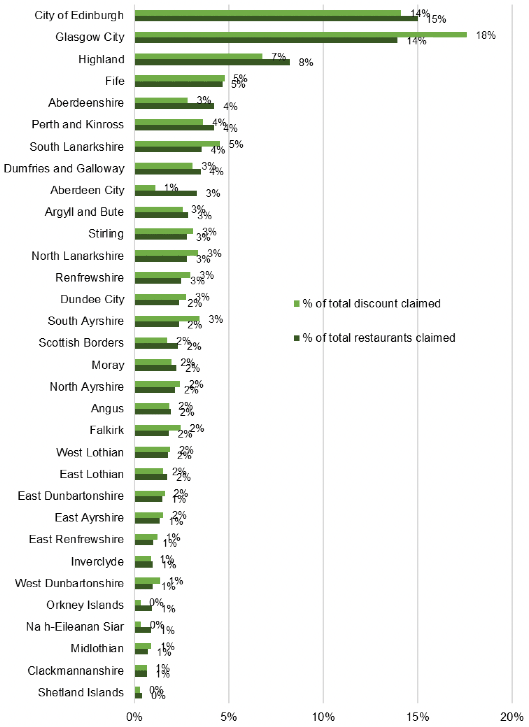
Source: HMRC
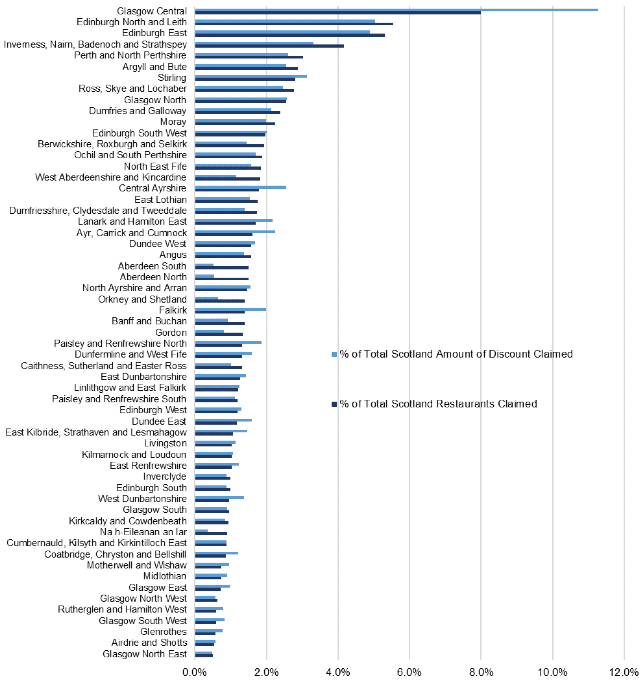
Source: HMRC
ii. Scottish Local Authority and Enterprise Agency Schemes (non-sector specific)
Business Support Fund Grants[78]
- What is it? Grants available to non-domestic ratepayers (NDR) in Scotland to help mitigate the impact of COVID-19 comprising: £10,000 Small Business Grant (SBG) available to ratepayers in all sectors as well as non-ratepayers who lease shared commercial space; £25,000 Retail, Hospitality and Leisure (RHL) grant. Rate payers eligible for 75% of the full amount on each subsequent property.
- Value: £1,019.53 million paid out
- Take-up: 91,258 grants awarded
- Status: Schemes closed 10 July.
91,258 grants had been awarded out of 106,662 applications, an award rate (grants awarded as a percentage of total applications) of 86%.[79] The total value of grants awarded stood at £1,019.53 million.
15,958 applications are reported to have been Rejected, Referred or Deferred (RRD). A vast majority of these are rejections of ineligible applications, while a very small number are referrals where the LA has asked the applicant for further supporting information or are waiting for the Assessor to make a decision relating to the property. Awards taken together with RRD mean that effectively all applications have been processed in some form. In addition, there is a small number of appealed cases, in which applicants have appealed either against a rejection, or against the amount awarded.
Of the 91,258 grants awarded, 80,708 (88%) were for the SBG, 9,151 (10%) were for the RHL and 1,399 (2%) were for non-NDR tenants. By value, (£785.0m) 77% was distributed via the SBG, (£220.5m) 22% via the RHL and (£12.9m) 1% through non-NDR tenants.
By sector grouping, it is estimated that 52,017 businesses in the retail sector received grants worth £581.1m. 29,533 awards were given to businesses in hospitality worth £266.9m and 9,126 awards to leisure businesses worth £102.0m.
By local authority, Fife (94%), East Lothian (91%) and East Dunbartonshire (90%) had the highest award rates while Perth and Kinross (75%) had the lowest (Chart A14). The geographical spread across LAs of grants awarded from the three grants together was broadly in line with the distribution of registered private sector businesses across Scotland's LAs (see Annex 4). Glasgow received the highest proportion by value (12% of the total) and number (12%), in line with its share of Scotland's registered private sector businesses (12%).
By urban/rural split, ratepayers in LAs classed as urban received 61% of grants by value (59% by number) while those in LAs classed as rural received 39% (41% by number). The award rate was found to be similar in LAs classed as urban (84%) and LAs classed as rural (85%).
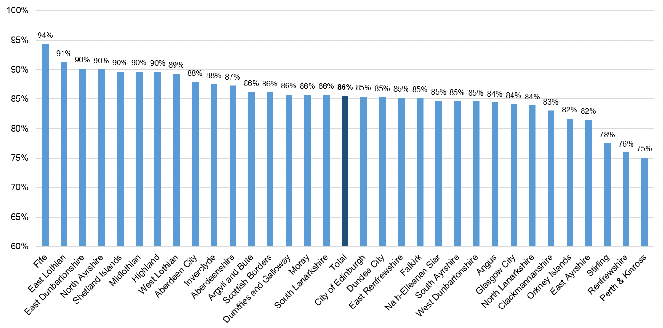
Source: Scottish Government
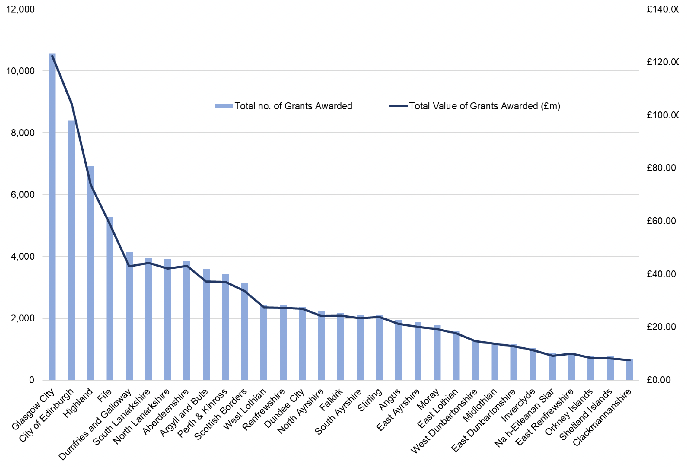
Source: Scottish Government
Non-Domestic Rates Relief (100% Retail, Hospitality, Leisure and Aviation [RHLA] & 1.6% Universal)
- What is it? A non-domestic rates relief to help the ratepayers (occupiers, or owner if no occupier) of certain non-domestic properties, including businesses, deal with the impact of coronavirus. The discounts include: 1.6% universal relief for on all non-domestic properties in Scotland effectively reversing the annual poundage increase; 100% relief for properties in the retail, hospitality and leisure (RHL) sectors, 100% relief for specified airports and other aviation-related subjects; and leniency towards requests for NDR payment deferrals by councils.
- Value: £965 million in 2020-21, as at 1 July 2020.
- Take-up: 250,940 properties as at 1 July 2020.
- Status: The 1.6% rates relief was available to non-domestic properties from 1 April 2020 to 31 March 2021. 100% rates relief will be available to retail, hospitality, leisure and eligible aviation businesses until at least 31 March 2022.
An estimated £965 million of NDR income was forgone in 2020-21 through both non-domestic rates relief measures (100% RHLA relief and 1.6% universal relief awarded to all properties). 28,400 properties have been supported through the RHL relief while all 250,940 received the 1.6% universal relief. NDR reliefs are administered by local authorities, meaning that the Scottish Government doesn't have data on applications. In 2020-21 both reliefs were automatically awarded, removing the need for applications to be made at all.
The statistics below relate to relief up to 1st July 2020:
The 1.6% universal relief was automatically made available to all properties in Scotland. The total value of the 1.6% universal relief as at 1 July 2020 was £61m, awarded to all 250,940 properties in Scotland. 174,730 of these were properties receiving a total of 100% relief, 11,870 received a relief other than the 1.6% universal relief but less than 100% total relief, while the remaining 64,350 received only this relief. A total of 76,220 properties therefore saw a net benefit of £34.4m from the 1.6% universal relief, of which properties receiving no other reliefs benefitted by £32.7m, and those receiving another relief but less than 100% in total benefitted by £1.7m
The RHLA relief awards a 100% relief to eligible RHL properties, as well as specified airports and aviation-related subjects. The value of this relief as at 1 July was £904m, awarded to 28,400 properties.
NDR data relates to property types, rather than uses, meaning it is difficult to make sectoral comparisons. However, by property class, it is estimated that the majority of rates relief went to shops (£618.6 million) while £122.7m went to hotels, £55m to leisure properties, and £51.4m to public houses and restaurants.
By local authority, the proportion of properties on the Valuation Roll receiving RHLA relief ranged between 4% in the Shetland Islands and Na h-Eileanan Siar, to 19% in City of Edinburgh. By value, City of Edinburgh (20%) also seen the greatest share of value followed by Glasgow City (16%). Overall, RHLA relief accounted for 54% of the value of all non-domestic rates reliefs, and for over 60% of the value of all reliefs in Aberdeen City, Renfrewshire, and the City of Edinburgh. It should be noted that many smaller properties received support through other non-COVID NDR reliefs, such as the Small Business Bonus Scheme relief.
A full breakdown is available in the Non-Domestic Rates Relief Statistics 2020 publication here: Non-Domestic Rates Relief Statistics 2020 - gov.scot (www.gov.scot).
| Relief status as at 31 May 2019 | All receiving RHL | ||
|---|---|---|---|
| Number of properties | Value of all reliefs as at 31 May 2019 (£m) | Value of all reliefs (incl. 1.6% relief) at 1 July 2020 (£m) | |
| On the Valuation Roll at 31 May 2019 but not receiving any relief | 21,190 | - | £843.7 |
| Receiving up to 25% total relief at 31 May 2019 | 2,950 | £6 | £39 |
| of which SBBS relief | 2,360 | £3.6 | £14.6 |
| of which other relief | 590 | £2.4 | £24.4 |
| Receiving more than 25%, but less than 100% relief at 31 May 2019 | 1,600 | £25.5 | £35.4 |
| of which includes charity | 880 | £17.8 | £22 |
| of which includes other reliefs | 720 | £7.6 | £13.5 |
| All properties receiving a higher relief percentage at 1 July 2020 than at 31 May 2019 | 25,740 | £31.5 | £918.2 |
| Receiving 100% relief at 31 May 2019 | 1,820 | £18.1 | £18.4 |
| of which SBBS relief | 1,240 | £4 | £4.1 |
| of which other relief | 570 | £14.2 | £14.3 |
| All RHL recipients in July 2020 that were on the Valuation Roll at 31 May 2019 | 27,560 | £49.6 | £936.7 |
| Not on the Valuation Roll at 31 May 2019 | 840 | - | £11.9 |
| Total RHL recipients as at 1 July 2020 | 28,400 | £49.6 | £948.6 |
Figures may not sum due to rounding.
The relief values are the awards given as at the snapshot date, and do not necessarily reflect the cost of a given award over the full year, for example some reliefs may be awarded later in the year and backdated, while some may have been cancelled before the snapshot date, or may be cancelled before the end of the year.
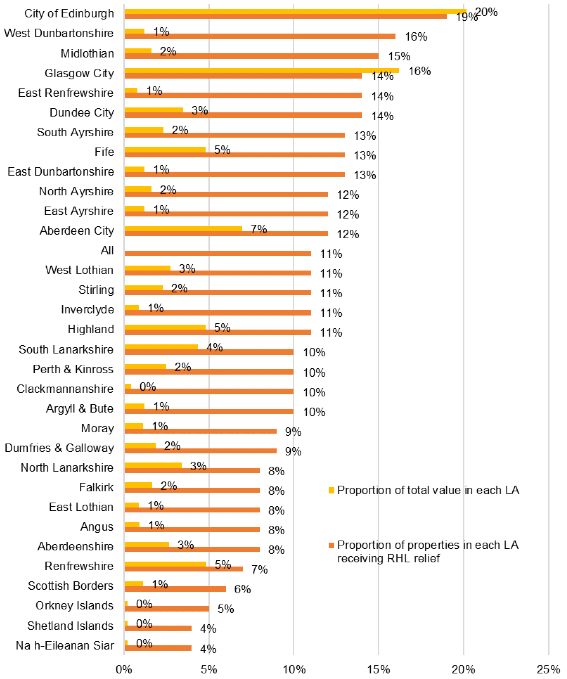
Source: Local Government Statistics
Strategic Framework Business Fund (SFBF)[80]
- What is it? The second core grant scheme that is local authority administered funding that has been made available to businesses affected by the COVID-19 restrictions under the Strategic Framework. The fund provided grants to businesses required to close by law or to significantly change its operations due to COVID-19 restrictions from 2 Nov 2020 (restrictions and closure grants):
- Temporary closure grant of £2,000 or £3,000 (depending on rateable value for the premises from which businesses operate) if it was required to close by law; or,
- Business restrictions grant of £1,400 or £2,100 (depending on rateable value for the premises from which businesses operate) if it could remain open but was specifically required to modify its operations by law, for example having to close earlier than normal. This did not include where a demand for products or services had been reduced because of the pandemic.
- Value: £344.78 million
- Take-up: 47,658 premises
- Status: Opened 2nd November 2020 and final payment 22nd March 2021.
£344,783,237 has been paid out to 47,658 premises under the Strategic Framework Business Fund (SFBF) business restrictions and closure grants (2 November 2020 to 22 March 2021, at scheme close). £419.57 million was allocated to the scheme, therefore 82% of the budget has been spent to date.
69% of the 69,150 premises applying for SFBF were accepted. 30% of applications were rejected, and 1% were either referred or deferred (the remaining less than 1% were still awaiting processing). The most common reason for rejected applications was that the business was in an 'ineligible sector' (53%).
By local authority, application success rate was highest in Aberdeenshire and Highland (both 91%) and lowest in Midlothian, Glasgow City and East Ayrshire (all 55%) (Chart A17). The majority of local authorities have disbursed between 60% to 100% of maximum forecast expenditure, for up to 22 March (Chart A18).
By size (in terms of rateable value), 89% of SFBF funds were paid to businesses with rateable value less than £51,000, the remaining 11% being paid to larger businesses.
92% (£318.78 million) of funds were paid out under the temporary closure fund with the remaining 8% (£26.00 million) paid out under the business restrictions fund. This reflects the nature and extent of Level 4 restrictions in place before and since 26 December 2020.
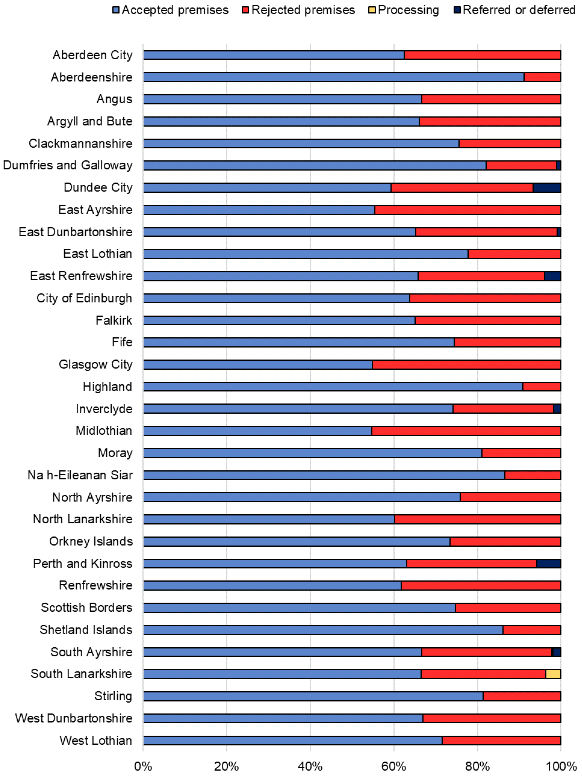
Source: SG
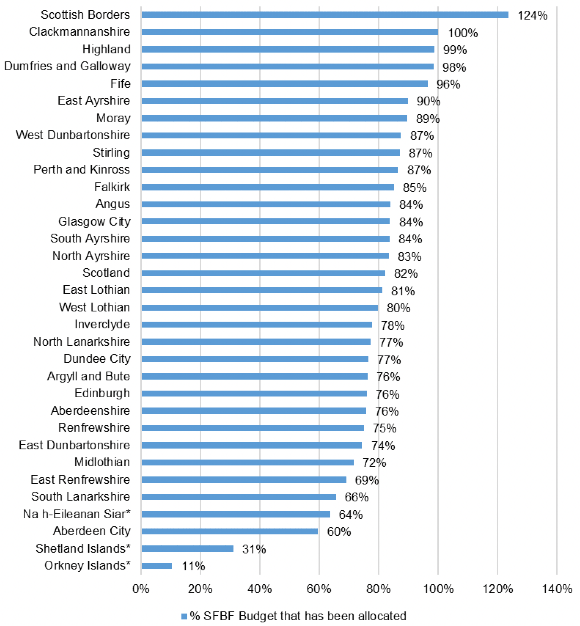
Source: SG
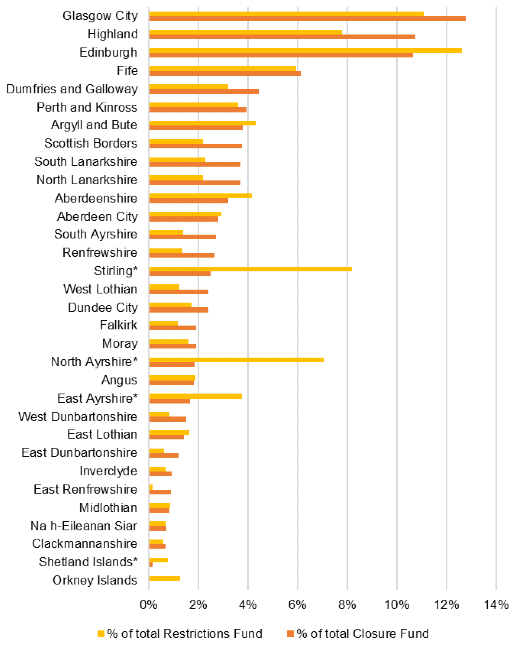
Source: SG
Strategic Framework Business Fund Transition Payment and Restart Grant[83]
- What is it? On 19 April 2021, all eligible SFBF and Island Equivalent Payment recipients automatically received a combined final transitional payment and one off restart grant to help them reopen.
- Non-essential retailer businesses received a payment of £7,000 (£1,000 transitional payment + £6,000 restart grant) for properties with a rateable value of below £51,000 or a payment of £7,500 (£1,500 transitional payment + £6,000 restart grant) for properties with a rateable value of more than £51,000.
- Hospitality and leisure businesses received a payment of £9,000 (£1,000 transitional payment + £8,000 restart grant) for properties with a rateable value of below £15,000; £13,000 (£1,000 transitional payment + £12,000 restart grant) for properties with a rateable value of between £15,000 and £51,000; or £19,500 (£1,500 transitional payment + £18,000 restart grant) for properties with a rateable value of above £51,001.
- All premises that received a grant award through any of the three waves of the Small Accommodation Providers Paying Council Tax Fund received a one-off grant of £9,000 (£1,000 SFBF equivalent payment + £8,000 restart grant).
- Value: £444.82 million (inc. small accommodation payments)
- Take-up: 49,222 premises paid
- Status: One-off grant on 19th April 2021. Now closed.
The Restart Grant and Transitional Payments paid out £431.98 million in Restart grants and transitional payments to premises already in receipt of Strategic Framework Business Fund or Island Equivalent Payments. In addition, Small Accommodation Providers that Pay Council Tax received £12.84 million in Restart grants and transitional payments. Together this totals £444,820,593.
'Non-essential Retail' and 'Hospitality and Leisure' premises previously in receipt of SFBF or IEP were eligible for the Restart Grant. Of those premises estimated to be eligible, 98% were paid. Those premises that were not paid were no longer eligible for various reasons, including where applications had been withdrawn, businesses had closed or relocated. The non-essential retail sector was paid a total of £155,259,143 (21,535 premises) and the Hospitality and Leisure sectors were paid a total of £280,717,450 (26,259 premises). Small accommodations paying council tax were paid a total of £12,844,000 (1,428 premises).
For non-essential retail premises, 95% was paid to smaller businesses (RV less than £51,000), with the remaining 5% going to larger businesses (RV greater than £51,000). For hospitality premises 60% was paid to the smaller premises (RV less than £15,000), 25% was paid to medium premises (between £15,000 and £51,000), and 15% were paid to the larger premises (RV greater than £51,000).
By local authority, Highland received the greatest share of the transitional payment (11%) while City of Edinburgh received the greatest share of the restart grant (12%) (Chart A20). Shetland Islands received the lowest share for both funds.
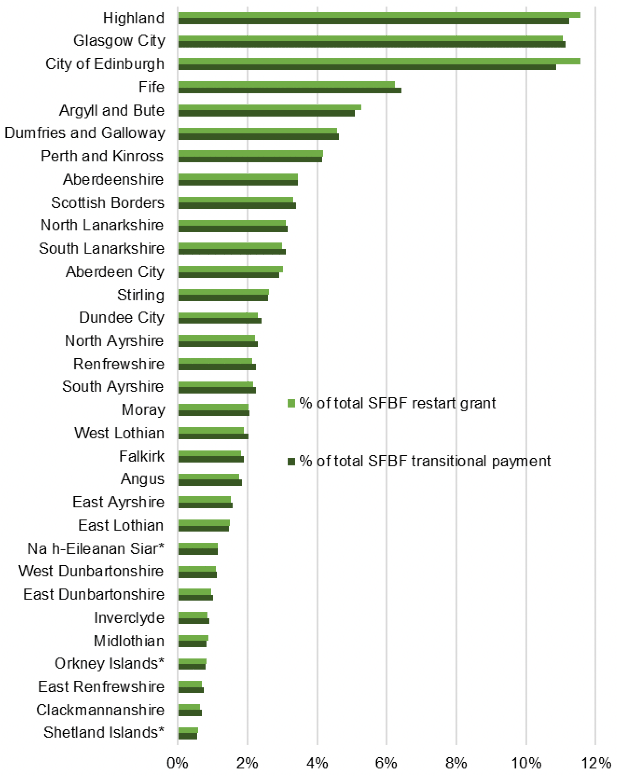
Source: SG
COVID-19 Local Restrictions Fund
- What is it? In recognition of the changes to dates originally set out in the Strategic Framework, SG provided additional support for businesses in local authorities which had been subject to restrictions for a longer period of time. Only businesses that previously received financial support through the SFBF were eligible for a grant through these schemes.
- Moray Localised Restrictions Fund - For the period from 17 May, additional support was provided to specific businesses in Moray while they remained in Level 3. A one off grant of up to £1,500 was provided for sectors that remained closed and up to £1,050 for businesses that required to modify their operations. Hospitality and tourism businesses were also eligible for a one-off grant of up to £1,000 in recognition of the impact of travel restrictions on the council area.
- Glasgow Localised Restrictions Fund - For the period from 17 May, additional support was provided to specific businesses in Glasgow for the duration they remained in Level 3. Up to £750 a week was provided for sectors that remained closed and up to £525 a week for businesses that required to modify their operations. Hospitality and tourism businesses were also eligible for a grant of up to £500 in recognition of the impact of travel restrictions on the council area.
- The 5 June Local Restrictions Support Fund provided financial support for businesses impacted by SG's decision on 2 June to retain Level 2 restrictions in 14 Local authority areas in response to rates of COVID-19. The fund offered grants of up to £750 each week to the soft play sector that remained closed in Level 2 but which was permitted to open elsewhere in Scotland from 5 June. Businesses required to modify their operations as a result of being in Level 2 were provided with support of up to £525 per week.
- Value: £9.3 million
- Take-up: 9,038 premises
- Status: Data as at June 2021.
As at 25 June 2021, the Localised Restrictions Fund has paid £388,600 to businesses in Moray and £2,308,275 to businesses in Glasgow under level 3 restrictions from 17 May 202). For the 14 local authorities under level 2 restrictions from 5 June 2021, the fund paid a total of £6,603,200 to 6,367 premises. A total of £9.3 million has been paid to 9,038 premises as at 25 June 2021.
Under the Level 2 restrictions, nearly all (99%, £6.5 million) of the funding was distributed through the Restrictions fund. The remaining funding (£73,250) was through the closures fund. By local authority, Glasgow and Edinburgh received the greatest share of the level 2 restrictions fund (both 27%). Glasgow (20%) also received the greatest share of funding through the closures fund followed by North Lanarkshire (18%).
Under the Level 3 restrictions, 2,019 premises in Glasgow City received 86% (£2.3 million) of the total amount paid out and 652 premises in received Moray 14% (£0.4 million). Nearly three quarters (73%) went to businesses with rateable value (RV) less than £51,000.
| Local Authority | RV < £51,000 | RV > £51,000 | Total | |||
|---|---|---|---|---|---|---|
| premise paid | amount (£) | premise paid | amount (£) | premise paid | amount (£) | |
| Glasgow | 1,587 | £1,612,650 | 432 | £695,625 | 2,019 | £2,308,275 |
| Moray | 621 | £363,800 | 31 | £24,800 | 652 | £388,600 |
| Total | 2,208 | £1,976,450 | 463 | £720,425 | 2,671 | £2,696,875 |
| Local Authority | RV < £51,000 | RV > £51,000 | Total | |||
|---|---|---|---|---|---|---|
| premise paid | amount (£) | premise paid | amount (£) | premise paid | amount (£) | |
| Clackmannanshire | 67 | 70,350 | 4 | 6,975 | 71 | 77,325 |
| Dundee | 272 | 281,850 | 61 | 81,525 | 333 | 363,375 |
| East Ayrshire | 194 | 204,150 | 26 | 40,950 | 220 | 245,100 |
| East Dunbartonshire | 82 | 86,550 | 10 | 15,750 | 92 | 102,300 |
| East Renfrewshire | 102 | 07,650 | 6 | 8,925 | 108 | 116,575 |
| Edinburgh | 1,208 | 1,269,750 | 319 | 502,425 | 1,527 | 1,772,175 |
| Glasgow | 1,245 | 1,307,600 | 306 | 482,775 | 1,551 | 1,790,375 |
| Midlothian | 96 | 101,700 | 18 | 28,350 | 114 | 130,050 |
| North Ayrshire | 236 | 249,150 | 22 | 34,650 | 258 | 283,800 |
| North Lanarkshire | 254 | 269,400 | 50 | 80,100 | 304 | 349,500 |
| Renfrewshire | 726 | 255,000 | 128 | 67,875 | 854 | 322,875 |
| South Ayrshire | 243 | 256,500 | 34 | 54,225 | 277 | 310,725 |
| South Lanarkshire | 355 | 371,450 | 47 | 74,175 | 402 | 445,625 |
| Stirling | 211 | 220,950 | 45 | 72,450 | 256 | 293,400 |
| Scotland | 5,291 | 5,052,050 | 1,076 | 1,551,150 | 6,367 | 6,603,200 |
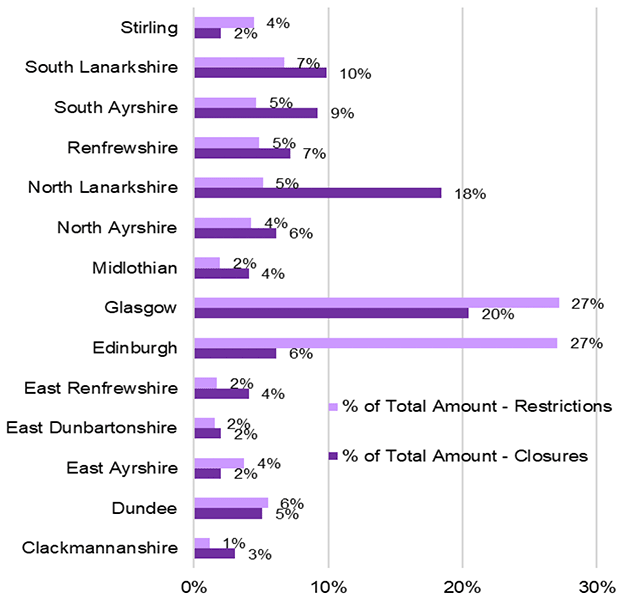
Source: SG
Local Authority Discretionary Fund (incl. Glasgow Top-Up)
- What is it? £120 million of funding provided to local authorities to provide additional support for businesses where they consider that necessary or justified. The aim of this fund is to mitigate the short term financial challenges being experienced by businesses adversely impacted by restrictions and regulations introduced since October to control the spread of COVID-19. It enables individual local authorities to direct additional financial support to specific groups, sectors or businesses within their local business communities who are experiencing immediate financial challenges as a result of current restrictions and regulations. Local authorities can use this fund at their discretion, and will undertake their own assessment of need and develop application processes accordingly.
- Value: £92.4 million
- Take-up: 22,902 premises
- Status: Opened December 2020 and closed 10 May 2021.
£92,394,065 has been awarded to 22,902 premises through the Local Authority Discretionary Fund as at 25 June 2021. 29,696 eligible applications have been received and 22,913 of these were successful. The application success rate is 77% with an average (mean) amount awarded of £4,032.39. The rejection rate is 22% and 1% of applications were still being processed. The main reasons reported for rejected applications was that applicants were unable to fully evidence criteria for fund, or that they were eligible for a different fund instead.
By local authority, the application success rate was highest in Scottish Borders and Perth and Kinross (both 87%) and lowest in East Renfrewshire (50%) (Chart A22). Glasgow and Edinburgh received the greatest share of funding.
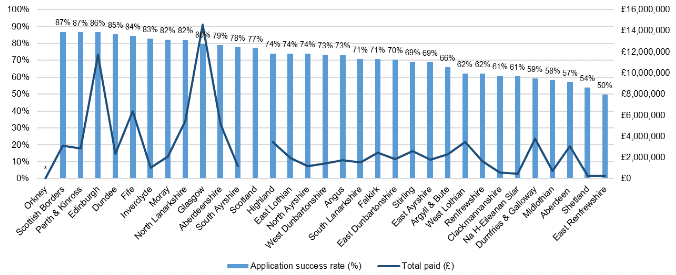
Source: Scottish Government
Hospitality, Retail and Leisure (HRL) Top Up Funds
- What is it? In addition to the grants businesses receive through the Strategic Business Framework Fund, eligible hospitality, retail and leisure businesses were also offered a one off grant of:
- £25,000 for larger hospitality businesses on top of the 4-weekly £3,000
- £6,000 for smaller hospitality businesses on top of the 4-weekly £2,000
- £9,000 for larger retail and leisure businesses on top of the 4-weekly £3,000
- £6,000 for smaller retail and leisure businesses on top of the 4-weekly £2,000
- Value: £234.3 million
- Take-up: 33,388 premises
- Status: Opened January 2021 and closed 22 February 2021.
£234,301,500 has been awarded to 33,388 hospitality, retail and leisure businesses through the HRL Top-up Funds. 96% of eligible premises in Scotland had been paid through the scheme as at 25 June 2021.
By local authority, Glasgow City and City of Edinburgh received the greatest share of both total premises paid and total value paid (Chart A23). £35.8 million was awarded to 4,832 premises in Glasgow City and £30.42 million to 3,836 premises in City of Edinburgh. Clackmannanshire, East Renfrewshire, Midlothian and Inverclyde received the lowest share of total premises paid and total value paid.
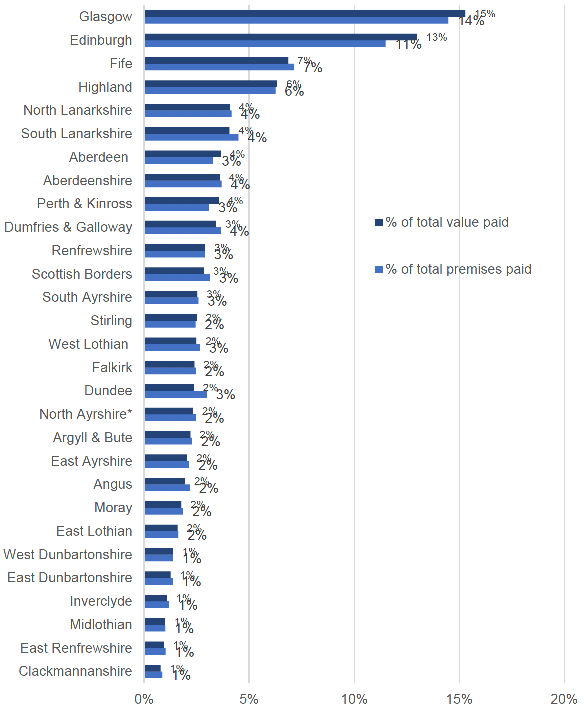
Source: SG
Island Equivalent Fund
- What is it? The island equivalent payment recognised that while islands faced a lower level of restrictions, there were significant impacts on many businesses. For eligible businesses, this fund brought the support available to them in line with similar businesses subject to Level 4 restrictions on the mainland, for January and beyond. This fund was available in Orkney, Shetland and Comhairle nan-Eilean Siar, and islands in Highland and Argyll and Bute. This consisted of:
- A temporary closure grant every four weeks, of one of the following:
- £2,000 if your business premises had a rateable value of up to and including £51,000
- £3,000 if your business premises had a rateable value of £51,001 or above
- Eligible retail and leisure businesses received:
- a one-off grant of £9,000 for relevant businesses with a rateable value of £51,001 or more
- a one-off grant of £6,000 for relevant businesses with a rateable value of up to and including £51,000
- Hospitality businesses received:
- a one-off grant of £25,000 for premises with a rateable value of £51,001 or more
- a one-off grant of £6,000 for premises with a rateable value of up to and including £51,000 (Restaurants, bars, pubs, licensed social and sports clubs, cafes and hotels were in scope for the hospitality top up payment.)
- A temporary closure grant every four weeks, of one of the following:
- Value: £7.7 million (+ £4.1 million top-up)
- Take-up: 1,660 premises (+ 605 premises from top-up)
- Status: Closed end of March 2021.
£7,653,700 was paid to 1,660 premises in the main round of the Island Equivalent Payment Scheme. A further 605 premises were paid in the top-up worth £4,068,000. This takes the total to £11,721,700 paid to 2,265 island businesses.
The application success rate for the main round of the scheme was 92% and the rejection rate was 8%. By local authority, the success rate was lower than average in Shetland (81%) and Orkney (85%). The greatest share of funding in the main round went to Argyll & Bute (41%) followed by Orkney (29%).
87% of eligible premises were paid through the top-up of the scheme. The greatest share of the top-up funding went to Na H-Eileanan Siar (32%), Shetland (25%) and Orkney (24%).
| Local Authority | total applications | No. approved | approved (%) | rejected (inc. referred/deferred) (%) | Processing (%) | premises paid | premise paid as % of accepted | Total paid (£) |
|---|---|---|---|---|---|---|---|---|
| Argyll & Bute | 611 | 611 | 100% | 0% | 0% | 559 | 91% | 3,146,100 |
| Highland | 46 | 46 | 100% | 0% | 0% | 23 | 50% | 149,400 |
| Na H-Eileanan Siar | 1,302 | 1,214 | 93% | 7% | 0% | 563 | 46% | 1,065,600 |
| Orkney | 467 | 395 | 85% | 15% | 0% | 330 | 84% | 2,184,600 |
| Shetland | 227 | 185 | 81% | 19% | 0% | 185 | 100% | 1,108,000 |
| Scotland | 2,653 | 2,451 | 92% | 8% | 0% | 1660 | 68% | 7,653,700 |
| Local Authority | Eligible premise | Eligible premise paid | % of eligible premises paid | Total paid (£) |
|---|---|---|---|---|
| Argyll & Bute | 103 | 103 | 100% | 716,000 |
| Highland | 41 | 6 | 15% | 39,000 |
| Na H-Eileanan Siar | 196 | 196 | 100% | 1,293,000 |
| Orkney | 198 | 152 | 77% | 991,000 |
| Shetland | 154 | 148 | 96% | 1,029,000 |
| Scotland | 692 | 605 | 87% | 4,068,000 |
Newly Self-Employed Hardship Fund[86]
- What is it? Support for newly self-employed individuals losing revenue due to the Coronavirus pandemic and who are ineligible for other COVID-19 support schemes such as the UKG's SEISS.
- Round 1 provided a £2,000 grant for self-employed individuals and Round 2 offered an additional £4,000 grant.
- Value: £45.9 million paid out.
- Take-up: 14,342 awards.
- Status: Round 1 closed 10 July 2020. Round 2 closed 23 March 2021.
For the 1st round of the scheme, 5,673 grants awarded out of 8,006 applications, an award rate of 71%. The total value of grants awarded stood at £11.3 million.
For the 2nd round of the scheme, 8,669 grants awarded out of 9,668 applications, an award rate of 90%. The total value of grants awarded stood at £34.6 million. This brings the total awarded through the scheme to £45.9 million with 14,342 successful applications.
The following statistics relate to the first round of the scheme:
By local authority, Glasgow (11%) and Edinburgh (9%) received the highest proportion of grants by value awarded and number of successful grants (again, 11% and 9% respectively).
Looking at award rates, Fife (86%), West Dunbartonshire (86%), and Shetland Islands (85%) and had the highest award rates while Orkney Islands (50%) and Glasgow City (56%) had the lowest.
By urban/rural split, businesses in LAs classed as urban received around two thirds (64%) of the grants awarded. The award rate was slightly higher in LAs classed as rural (72%) than in LAs classed as urban (70%).
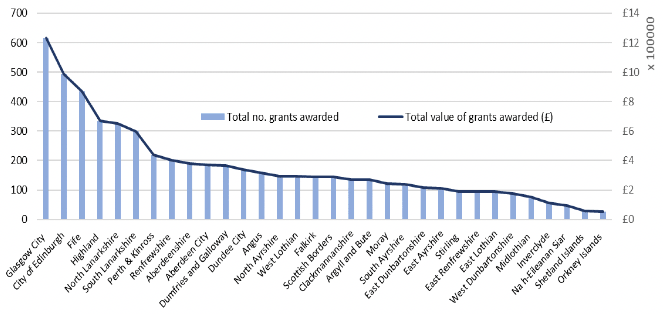
Source: Scottish Government
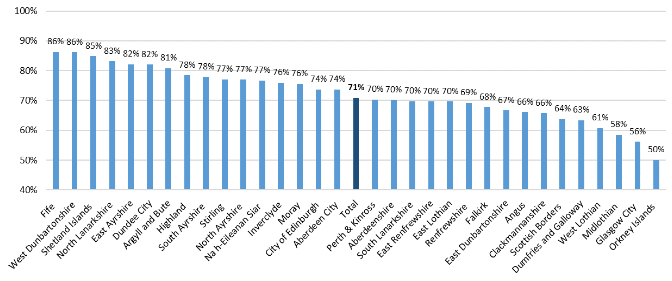
Source: Scottish Government
Creative, Tourism and Hospitality Enterprises Hardship Fund[87]
- What is it? Grant funding for small (less than 50 employees) creative, tourism and hospitality businesses losing revenue due to the Coronavirus pandemic who are ineligible for other COVID-19 business support (except the Coronavirus Job Retention Scheme)
- Value: £23.6 million grants offered (£30 million available)
- Take-up: 1,894 applications approved.
- Status: Scheme closed. Final headline figures provided.
1,894 applications have been approved out of a total of 3,413 valid applications,[88] an award rate of 55%. If we consider only valid, eligible applications[89] (1,908 of the total applications were deemed valid and also to have met eligibility criteria), the award rate rises to 99%. The total value of grants offered stood at £23.6 million. The average grant offer was £12,400.
By sector, over two thirds of grants offered were to businesses in the tourism and hospitality sector (76% of the total value of grants offered and 71% of the total number) while around a quarter went to the creative sector (24% by value and 29% by number of grants offered).
The geographical spread across local authorities of grants offered was broadly in line with the distribution of registered private sector businesses in the 'Accommodation and Food Services' and 'Arts, Entertainment and Recreation' sectors across Scotland's LAs (see Annex 4). Highland (14% by number of grants offered and 12% by value), Edinburgh (13% by number and 15% by value) and Glasgow (13% by number and 14% by value) had the highest proportion of grants offered by value and number of grants, together accounting for around 40% of grants offered (Chart A26). These three LAs together accounted for 34% of registered private sector businesses in the 'Accommodation and Food Services' and 'Arts, Entertainment and Recreation' sectors in 2020.
By business size,[90] micro businesses (0-9 employees) made up the majority (86%) of total applications and received 75% of the total value offered. Small businesses (10-49 employees) made up 14% of total applications and were offered 25% of the total value offered (Chart A27).
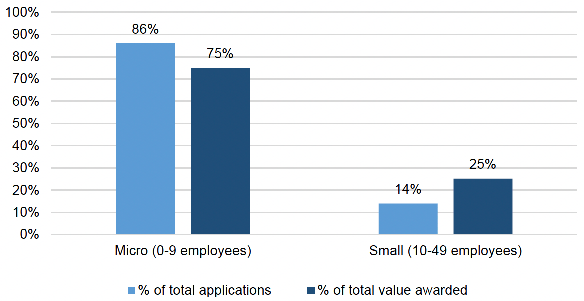
Source: Enterprise Agencies, data as at 4th August 2020.
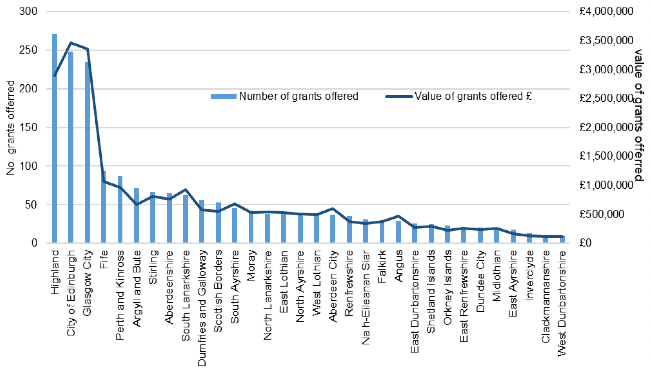
Source: Enterprise Agencies, data as at 9th Sept 2020.
Pivotal Enterprise Resilience Fund (PERF)[91]
- What is it? Grants for viable but vulnerable SMEs who are vital to Scotland's economy, locally or nationally.
- Value: £121.8 million offered (£120 million available)
- Take-up: 1,763 applications approved.
- Status: Scheme closed. Final headline figures provided.
1,763 applications have been approved out of a total of 5,069 valid applications,[92] an award rate of 35%. If we consider only valid, eligible applications[93] (3,995 of the total applications were deemed valid and also to have met eligibility criteria), the award rate rises to 44%. The total value of grants offered stood at £121.8 million. The average grant offer was £69,000.
Five sectors, 'Tourism & Hospitality, 'Other manufacturing', 'Construction', 'Wholesale and Retail' and 'Creative Industries', together accounted for almost two thirds (61%) of grants offered by value and number of businesses (Chart A28).
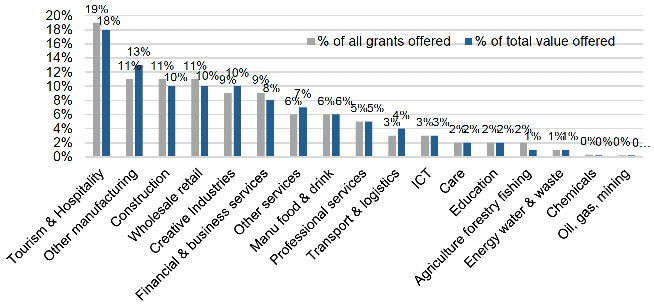
Source: Enterprise Agencies
By business size, small businesses (10-49 employees) made up over half (55%) of total applications and total value awarded (58%). Micro businesses (0-9 employees) made up 29% of total applications and received 17% of the total value awarded. Medium-sized businesses made up 15% of total applications and received a quarter of the total value awarded (25%) (Chart A29).
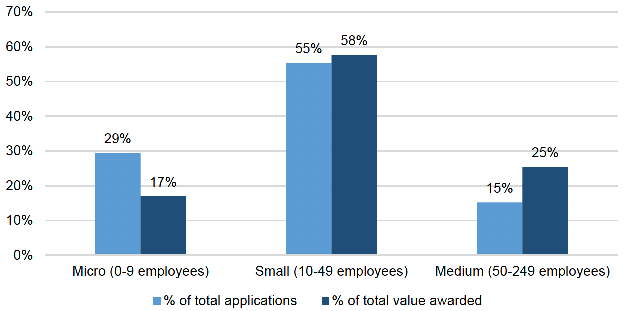
Source: Enterprise Agencies
By local authority, Highland (11% by number of grants offered and 9% by value), Glasgow (10% by number and 12% by value) and Edinburgh (9% by number and 11% by value) had the highest proportion of approvals by value and number of grants, together accounting for around a third of total grants awarded (Chart A30). These three LAs together account for just under a third (29%) of registered private sector businesses in Scotland (see Annex 4).
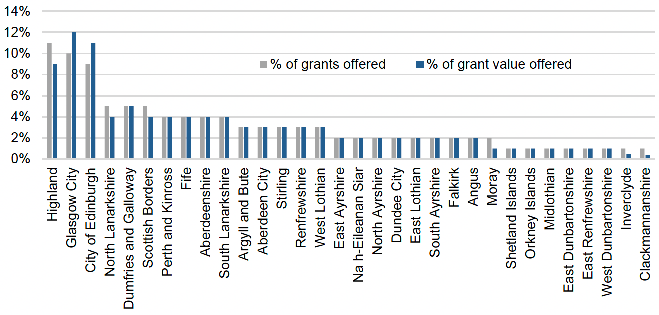
Source: Enterprise Agencies
iii. Scottish Sector Specific Schemes
Business Contingency Fund Plus Grants (Travel Agents, Brewers and Indoor Football Centres)
- What is it? Contingency Fund to support brewers, travel agents and indoor football centres in recognition of the specific challenges that businesses operating in these sectors are experiencing as a result of COVID-19 restrictions and regulations. Eligible businesses will receive grants of up to £25,000, depending on the rateable value of the premises from which they operate. Brewers may be eligible for an additional £5,000 based on their annual production. Eligible businesses will receive a:
- £10,000 for premises which have a rateable value of up to and including £18,000
- £25,000 for premises which have a rateable value of £18,001 or above
- For Breweries only: £30,000 for a property from which they operate with a rateable value of over £51,000 or production over 5,000 HL in 2019
- Value: £5.4 million
- Take-up: 345 businesses
- Status: Closed 31 March 2021.
A total of £5,391,250 has been awarded to 345 premises through the Business Contingency Plus Fund.
(a) Travel Agents
£3,670,000 has been paid to 233 premises defined as Travel Agents. Travel Agents received the greatest share of funding under the contingency fund plus grants (68% of total value and premises).
By size, 143 smaller premises (rateable value £18,000 or under) were awarded £1,430,000 and 90 larger premises (rateable value over £18,000) were awarded £2,240,000.
By local authority, Glasgow received the greatest share of travel agents supported and value awarded (both 16% of total). This was followed by Edinburgh (9% of number and 10% value) and Fife (6% of number and 10% value).
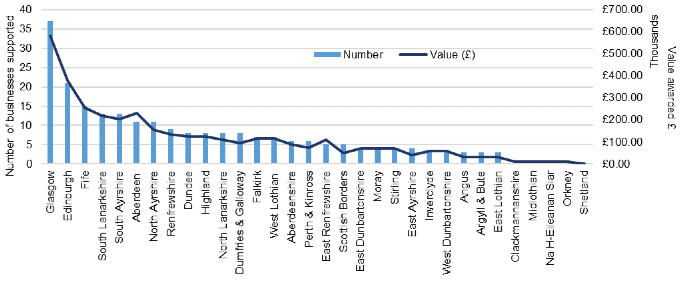
Source: SG
(b) Breweries
£1,516,250 has been paid to 102 premises defined as Breweries. Breweries received 30% of total value and made up 28% of total premises under the contingency plus fund.
By size, 70 smaller premises (rateable value £18,000 or under) were awarded £700,000, 15 medium premises (rateable value between £18,001 and £15,000) were awarded £356,250 and 17 large premises (rateable value over £51,100) were awarded £460,000.
By local authority, Highland received the greatest share of breweries supported (13%) with 11% of value awarded. This was followed by Edinburgh (12% of number and 13% value) and Glasgow (both 8%).
Source: SG
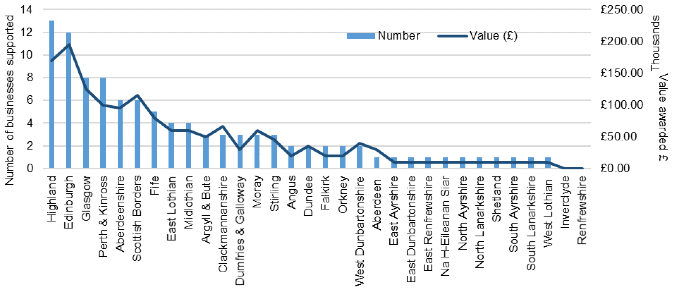
(c) Indoor Football Centres
£205,000 has been paid to 10 premises defined as indoor football centres. Indoor football centres received the lowest share of funding (4% of total value and made up 3% of total premises).
By size, 3 smaller premises (rateable value £18,000 or under) were awarded £30,000 and 7 large premises (rateable value over £18,000) were awarded £175,000.
By local authority, only eight local authorities in Scotland had businesses that received support. Glasgow had two businesses receiving support worth £50,000 followed by West Dunbartonshire where 2 businesses received £20,000).
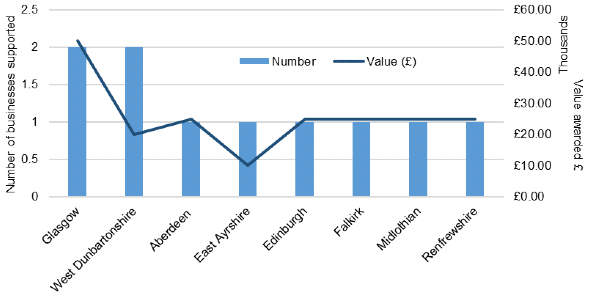
Source: SG
Support for Small Accommodation Providers Paying Council Tax Fund
- What is it? Fund is designed to support eligible B&Bs, guest houses and self-catering accommodation that have experienced financial hardship as a result of coronavirus protection measures. It covers businesses which do not pay non-domestic rates but pay council tax, and is part of wider support for the tourism and hospitality sector.
Eligible businesses received a grant of £2,000 every 4 weeks. Payments backdated to the start of January 2021 and cover until the 31st March 2021, the period of which Level 4 restrictions have applied from 26th Dec 2020. The fund was delivered in three waves. - Value: £8.8 million
- Take-up: 1,481 premises
- Status: Closed.
Across the three waves of the funds, 1,481 applications had been awarded with a total value of £8,830,000 million.
348 premises were paid under the first wave with a value of £2,076,000. 133 premises were paid under the second wave with a value of £786,000. 1,000 premises were paid under the third wave with a value of £5,968,000.
By local authority, Highland received the greatest share of support for both number of premises and value across the three waves of the support (Table A8), reflecting the targeting of the support to small accommodation providers.
| Wave 1 premise paid | Wave 2 premise paid | Wave 3 premise paid | ||||
|---|---|---|---|---|---|---|
| Local Authority | Number | Value (£) | Number | Value (£) | Number | Value (£) |
| Aberdeen | - | - | 1 | 6,000 | 11 | 66,000 |
| Aberdeenshire | 3 | 18,000 | 1 | 6,000 | 25 | 144,000 |
| Angus | 5 | 30,000 | 2 | 12,000 | 16 | 96,000 |
| Argyll & Bute | 26 | 156,000 | 9 | 54,000 | 68 | 408,000 |
| Clackmannanshire | 1 | 6,000 | 2 | 12,000 | - | - |
| Dumfries & Galloway | 14 | 84,000 | 7 | 42,000 | 21 | 126,000 |
| Dundee | - | - | - | - | - | - |
| East Ayrshire | 3 | 18,000 | 2 | 12,000 | 6 | 36,000 |
| East Dunbartonshire | 1 | 6,000 | - | - | 1 | 6,000 |
| East Lothian | 4 | 24,000 | 2 | 12,000 | 11 | 66,000 |
| East Renfrewshire | 1 | 6,000 | 1 | 6,000 | - | - |
| Edinburgh | 8 | 48,000 | 3 | 18,000 | 87 | 522,000 |
| Falkirk | 2 | 12,000 | - | - | 7 | 42,000 |
| Fife | 13 | 78,000 | 5 | 30,000 | 49 | 294,000 |
| Glasgow | - | - | 1 | 6,000 | 65 | 390,000 |
| Highland | 152 | 912,000 | 61 | 366,000 | 417 | 2,500,000 |
| Inverclyde | - | - | 1 | 6,000 | 2 | 12,000 |
| Midlothian | 3 | 18,000 | - | - | 1 | 6,000 |
| Moray | 13 | 78,000 | 3 | 18,000 | 34 | 204,000 |
| Na H-Eileanan Siar | 28 | 168,000 | 6 | 36,000 | 30 | 180,000 |
| North Ayrshire | 5 | 30,000 | 2 | 12,000 | 17 | 102,000 |
| North Lanarkshire | 1 | 6,000 | - | - | 7 | 42,000 |
| Orkney | 9 | 54,000 | 6 | 36,000 | 15 | 90,000 |
| Perth & Kinross | 11 | 66,000 | 5 | 30,000 | 33 | 198,000 |
| Renfrewshire | - | - | - | - | - | - |
| Scottish Borders | 11 | 54,000 | 3 | 14,000 | 20 | 108,000 |
| Shetland | 6 | 36,000 | - | - | 11 | 66,000 |
| South Ayrshire | 6 | 36,000 | - | - | 4 | 24,000 |
| South Lanarkshire | 2 | 12,000 | - | - | 5 | 30,000 |
| Stirling | 16 | 96,000 | 4 | 16,000 | 31 | 174,000 |
| West Dunbartonshire | 1 | 6,000 | 3 | 18,000 | 3 | 18,000 |
| West Lothian | 3 | 18,000 | 3 | 18,000 | 3 | 18,000 |
| Scotland | 348 | 2,076,000 | 133 | 786,000 | 1,000 | 5,968,000 |
Taxi and Private Hire Driver Support Fund (March 2021)[94]
- What is it? Grants for licensed taxi or private hire drivers impacted by Covid-19 restrictions. The support consisted of a one-off grant of £1,500.
- Value: £32.8 million
- Take-up: 21,838 awards
- Status: Closed
21,838 drivers have been paid through the scheme out of 33,767 eligible drivers, a success rate of 65%. Total spend under the scheme stood at £32,757,500 as at 25 June 2021.
99% of the eligible drivers were contacted through their local authority and 70% subsequently returned an application (23,805 applications). 2,039 applications were rejected (6% of eligible drivers and 9% of applications received). The main reasons for rejection were failure to supply supporting evidence (42%) and duplicate application (38%).
By local authority, Glasgow (21%) and Edinburgh (20%) received the greatest share of total value paid through the scheme. Orkney, Aberdeenshire, Shetland, Clackmannanshire, Moray and Na H-Eileanan Siar received the least in terms of value (all 0%). Looking at the percentage of eligible drivers paid in each LA, Dundee paid the greatest share (90%), followed by Falkirk (79%), West Dunbartonshire (78%) and South Ayrshire (78%). Aberdeenshire (6%), Shetland (28%) and Moray (28%) paid the lowest share of eligible drivers in their LA.
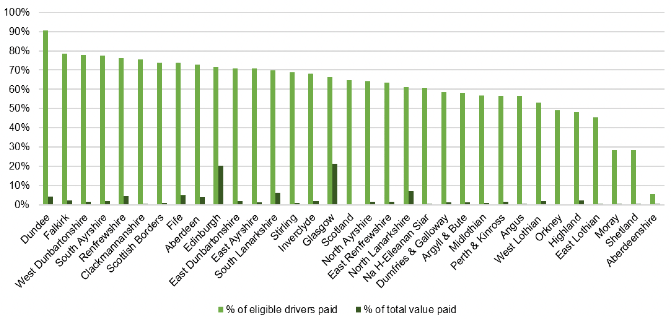
Source: SG
Coronavirus Liquidity Support for SME Housebuilders[95]
- What is it? Emergency loan fund to support SME housebuilders experiencing liquidity issues due to the temporary closure of housebuilding sites by COVID-19. Loans ranging from £50k to £1m.
- Value: £18.0m approved loans.
- Take up: 38 businesses approved.
- Status: Scheme closed 29 June 2020.
38 applications had been approved out of 52 submitted, an award rate of 73%. Loans approved to date are worth £18,020,417. 14 applications were rejected, a rejection rate of 27%.
The average (mean) loan amount requested was £485,808 and the average loan amount approved was £474,221 (98% of value requested).
By area, Glasgow and Edinburgh & Lothians received the greatest number of applications with 12 each.
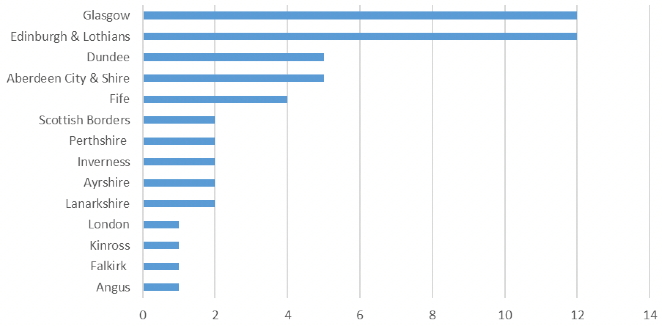
Source: Scottish Government
Museums and Galleries Scotland Funds[96]
- What is it? Funding schemes to support the museums and galleries sector through the challenges created by the COVID-19 pandemic they comprise:
- (a) COVID-19 Museum Development Fund - This fund was available to Local Authority museums, museums managed by ALEOs and University museums to deliver projects to help them build resilience and address some of the challenges brought about by the pandemic.
- (b) Recovery and Resilience Fund - This fund was open to Accredited and non-Accredited independent museums to apply for support to help them recover from the impact of the Coronavirus pandemic and build resilience and sustainability
- (c) Covid-19 Adaptation Fund - This fund is open to all museums to support the costs of making adaptations necessary in order to reopen safely and in accordance with restrictions due to Covid-19. Museums can apply for up to £7,500.
- (d) Urgent Response COVID-19 Fund - This fund was open to independent Accredited museums critically affected by the loss of income as a result of the COVID-19 pandemic and supported them with 3 months of operating costs.
- (e) Digital Resilience Covid-19 Fund - This fund was open to all museums to support the purchase of equipment and software that would enable them to adapt to more digital working during the period of closures brought about by COVID-19.
- Value: £8.7 million across the five listed funds.
- Take-up: 351 awards
- Status: All closed.
A total of £8,693,756 million was paid out through 351 awards under the following five Museums and Galleries Scotland funds.
(a) COVID-19 Museum Development Fund
A total value of £805,584 was paid to 22 organisations in Scotland through the Museum Development Fund. The average amount paid out through the scheme was £36,617. The largest awards were given to Aberdeen City Council and High Life Highland (both £60,000).
| Organisation | Amount Awarded |
|---|---|
| Aberdeen City Council | £60,000 |
| ANGUSalive | £55,072 |
| City of Edinburgh Council | £55,125 |
| Culture Perth and Kinross | £38,624 |
| Dumfries and Galloway Council | £48,000 |
| East Dunbartonshire Leisure & | £58,529 |
| East Lothian Council | £2,496 |
| Falkirk Community Trust | £20,404 |
| Fife Cultural Trust | £23,925 |
| Glasgow Life, Glasgow Museums | £59,520 |
| High Life Highland | £60,000 |
| Inverclyde Council | £51,577 |
| Renfrewshire Leisure Ltd. | £25,909 |
| Robert Gordon University | £34,527 |
| University of Aberdeen | £43,989 |
| University of Dundee | £24,034 |
| University of Edinburgh | £25,200 |
| University of Edinburgh | £21,756 |
| University of St Andrews | £38,504 |
| University of Stirling | £11,652 |
| West Lothian Council | £7,562 |
| Western Isles Council - Comhairle nan Eilean Siar | £39,179 |
| Total | £805,584 |
(b) Recovery and Resilience Fund
90 awards paid through this scheme out of 116 applications, an award rate of 78%. A total of £4.6 million was paid out through this scheme. An additional 59 awards were paid through the top-up of the Recovery and Resilience fund worth £2.3 million. 60 applications were filed for the scheme with an award rate of 98%. A total of 149 awards were paid through the scheme worth £6,877,366. The greatest share of funding went to Dundee Heritage Trust (14%, £953,299).
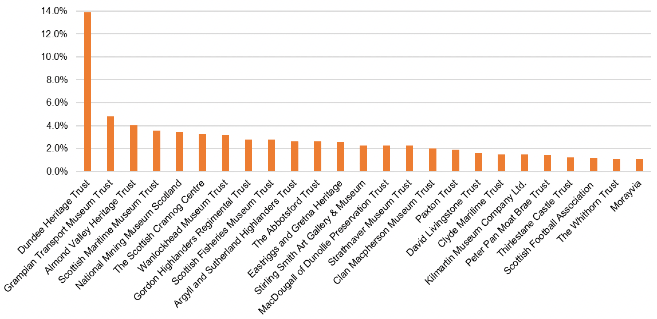
Source: Museums and Galleries Scotland
(c) COVID-19 Adaptation Fund
92 awards paid through this scheme out of 97 applications, an award rate of 95%. A total of £300,000 was paid out through this scheme. The average (mean) amount was £3,260.
(d) Urgent Response COVID-19 Fund
20 awards paid through this scheme out of 29 applications, an award rate of 69%. A total of £600,000 was paid out through this scheme. The average (mean) amount was £30,000.
(e) Digital Resilience COVID-19 Fund
68 awards paid through this scheme out of 77 applications, an award rate of 88%. A total of £110,806 was paid out through this scheme. The average (mean) amount was £1,629. The greatest share of funding went to the Ferryhill Railway Trust, Museum of Scottish Lighthouses, National Mining Museum Scotland and Scottish Maritime Museum Trust (all 2.7%, £3,000).
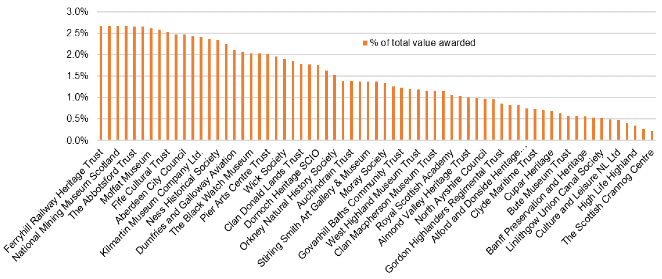
Source: Museums and Galleries Scotland
Scottish Wedding Industry Fund[97]
- What is it? Fund for eligible businesses whose main income comes from the wedding sector (e.g. caterers, cakes, marquee hire, photographers), offering grants of between £5,000 and £25,000 depending on turnover. It was available to companies, sole traders, partnerships, registered charities and trusts. It was managed by a partnership of South of Scotland Enterprise, Scottish Enterprise and Highlands and Islands Enterprise on behalf of the Scottish Government.
- Value: £25.8 million
- Take-up: 2,808 awards
- Status: Closed 25th February 2021.
2,817 awards have been successful through the same out of 3,478 applications, an award rate of 81%. A total of £25,800,000 has been paid out through the scheme to date to 2,808 awards. The average amount awarded was £9,188.
Mobile and Home Based Close Contact Services Fund[98]
- What is it? The fund is for owners and operators of mobile and home-based close contact service businesses and for registered driving instructors. It is not for employees of those businesses. Eligible applicants will receive a one-off £4,000 payment.
- Value: £35.7 million
- Take-up: 8,940 businesses
- Status: Closed 23 March 2021.
8,940 businesses have been paid through the same out of 10,033 applications, an award rate of 89%. A total of £35,700,000 has been paid out through the scheme to date.
Events Industry Support Fund (first round)[99]
- What is it? The Events Industry Support Fund and Events Industry Support Fund 2 were set up to provide financial support to event businesses, particularly those in the industry's supply chain, as they dealt with the ongoing impact of COVID-19. The funding was administered by VisitScotland on behalf of the Scottish Government.
- Value: £5 million
- Take-up: 505 awards
- Status: Both rounds closed - 1st round closed 14 September 2020 and 2nd Round 26 February 2021.
The following data refers to the first round of the events industry support fund. 505 awards have been paid through the same out of 833 applications, an award rate of 61%. A total of £5,000,000 has been paid out through the scheme to date out of the allocated £6,000,000. An average amount of £9,900 was awarded.
Visitor Attractions Support Fund[100]
- What is it? £10 million fund delivered by VisitScotland on behalf of Scottish Government and was developed with input from the Association of Scottish Visitor Attractions (ASVA). Aim to support Scottish businesses in the attractions sector that have been severely affected by the impact of the COVID-19 pandemic, to help keep them in business while restrictions on opening and travel are still in place, and to support them to prepare for reopening in 2021 when restrictions are lifted.
This fund was open to visitor attractions with an annual turnover in excess of £10,000. A range of award amounts to be awarded under this Fund, up to a maximum of up to £50,000 per Visitor Attraction, depending on the level of turnover for that Visitor Attraction - Value: £9.7 million
- Take-up: 340 businesses
- Status: Closed 19th February 2021.
340 awards have been paid through the same out of 407 applications, an award rate of 84%. A total of £9,700,000 has been paid out through the scheme to date. The average amount awarded was £28,529.
Scotland Coach Operators COVID-19 Business Support and Continuity Fund[101]
- What is it? Fund to provide financial support for Scottish based businesses in the coach operator sector critical to Scotland's tourism economy and for businesses who didn't meet the criteria for the previous coaches fund. The Fund was designed to support businesses that are facing hardship due to the impact of the pandemic to keep them in business while restrictions on travel are still in place, and to support them to prepare for recommencing operations when restrictions are lifted. It will provide targeted support to those businesses who are operating the newest and most environmentally friendly vehicle fleet. The Fund was delivered in two strands on behalf of SG by Visit Scotland, with development input from the Confederation of Passenger Transport. The amount awarded to each applicant was determined by the eligibility criteria and businesses could not receive both strands.
- Value: £8.4 million
- Take-up: 117 businesses
- Status: 1st strand closed 23rd February and 2nd strand closed 30th June 2021.
117 awards have been paid through the same out of 147 applications, an award rate of 80%. A total of £8,400,000 has been paid out through the scheme to date with an average award value of £72,649.
The following data relates to strand one of the fund:
Award amounts ranged from £4,500 to £700,000 under the first strand of the Coach Operators COVID-19 Business Support and Continuity Fund. By organisation, the largest grant worth £700,000 went to Parks of Hamilton (Coach Hirers) Ltd. This was followed by £339,000 to Maynes Coaches Ltd and £327,000 to Edinburgh Coach Lines Ltd. Value awarded by organisation can be found here: Scotland's coach tourism & coach private hire sector fund - COVID-19 | VisitScotland.org.
Culture Collective Fund[102]
- What is it? Fund to support a network of creative practitioners, organisations and communities in response to Covid-19 to provide employment opportunities. Organisations based in Scotland whose work involves the arts, screen and creative industries. Funds are to develop and deliver creative projects with communities. No strict definition of the type of activity which can be supported. Applicants should demonstrate a significant track record of working with the communities they are seeking to reach. All applicants must be not-for-profit.
- Value: £5.9 million
- Take-up: 26 awards
- Status: Closed 16th December 2020.
26 awards have been paid through the same out of 64 applications, an award rate of 41%. A total of £5,891,553 has been paid out through the scheme to date with an average award value of £226,598.
By region, the greatest share of funding went to Lothians (31% by number of awards and 28% by value), followed by Highlands and Islands (19% by number of awards and 24% by value). Excluding Mid Scotland and Fife region that received no funding through this scheme, Central Scotland received the smallest share of funding (4% by number of awards and 2% by value).
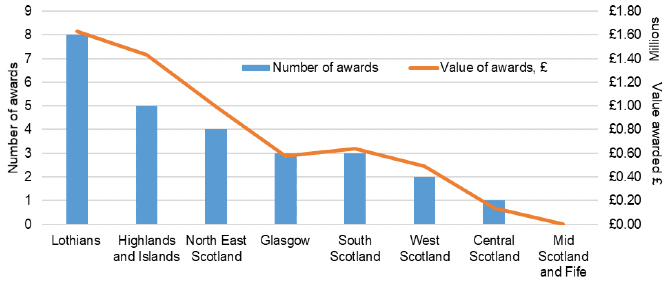
Source: Creative Scotland
Hardship Fund Creative Freelancers[103]
- What is it? The Scottish Government committed £17m through Creative Scotland and Screen Scotland for creative freelancers who are experiencing hardship due to lost income from work and/or practice in the creative sector due to COVID-19. The funds offer a one-off monetary contribution to those who are most deeply impacted and disadvantaged by the cancellation of work.
£8m was administered between October 2020 and February 2021. A further £9m was administered in March 2021. Bursaries can be requested for any sum from £500 – £2000. For the latest round, as well as supporting new applicants, previous recipients of the fund who have been awarded funding can also apply again for a further award of up to £2k. - Value: £16.8 million
- Take-up: 4,639 awards
- Status: Closed 22 March 2021.
4,639 awards have been paid through the same out of 4,816 applications, an award rate of 96%. A total of £16,800,000 has been paid out through the scheme to date with an average award value of £3,621.
The following data is for the funding administered between October 2020 and February 2021:
By region, the greatest share of funding went to Glasgow (39% by number of awards and 38% by value). North East Scotland received the smallest share of funding through the scheme (both 5%).
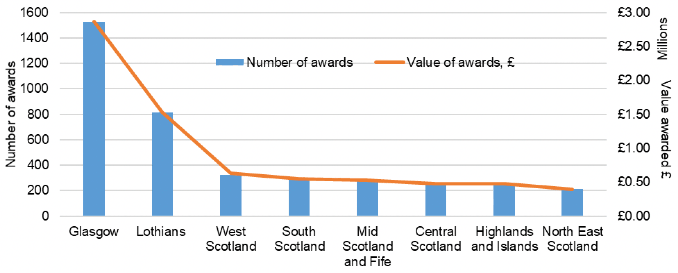
Source: Creative Scotland
Cultural Organisations and Venues Recovery Fund
- What is it? This fund is part of the package of COVID-19 support established by the Scottish Government and delivered by Creative Scotland to help support organisations that are vital to the cultural life of Scotland and require funding to help prevent insolvency and/or significant job losses due to the impact of COVID-19. Applicant companies or sole traders need to have been working in Scotland's culture sector before April 2019 and be at significant threat of insolvency or significant job losses as a result of COVID-19 restrictions. Those awarded up to £150k in the first round of this fund could apply for support in the second round, up to a maximum of £75k. Those awarded over £150k in the first round of this fund could apply for support up to a maximum of £125k in second round.
- Value: £13.2 million
- Take-up: 233 awards
- Status: 2nd round closed 24th June 2021.
233 awards have been paid through the same out of 348 applications, an award rate of 67%. A total of £13,200,000 has been paid out through the scheme as at 25th June 2021. The average amount awarded was £56,652.
The following data is for round 1 of the scheme as at 5 th November 2020:
203 organisations and venues across Scotland have received a total of £11,751,844 in emergency support through the first round of the scheme as at 5 November 2020.
By creative sector, the greatest share of value of funding went to the Nightclub sector (27%), which received 33 awards worth £3,151,288. This was followed by the Venues/ Art Centres (17%), Support Infrastructure (13%) and Events/ Festivals (12%). Businesses in the Magic sector received the smallest share of funding (0.002%) worth £23,199. Publishing businesses received the largest average award (£113,000) compared to average £57,891.
By local authority, Glasgow City (38%) and City of Edinburgh (26%) received the greatest share of value of funding. 71 awards were successful in Glasgow City worth £4,512,618 and 46 were awarded in City of Edinburgh worth £3,104,740. Orkney Islands received the smallest share of funding (0.1%) worth £10,000 to one award. Renfrewshire received the largest average award (£108,000) compared to average £57,891.
By organisation, the largest awards went to Margaret McIver Ltd (Barrowlands), Salt 'n' Sauce Promotions Ltd. (The Stand) and Skerryvore Ltd (Oran More) all worth £250,000 and located either in Glasgow City or City of Edinburgh.
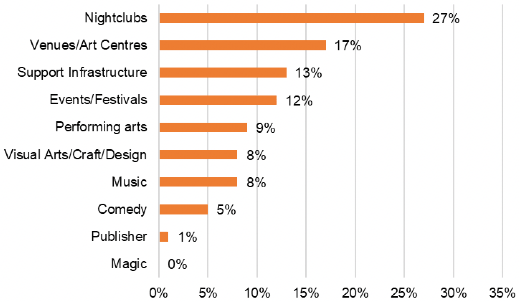
Source: Creative Scotland - data as at 5th Nov 2020
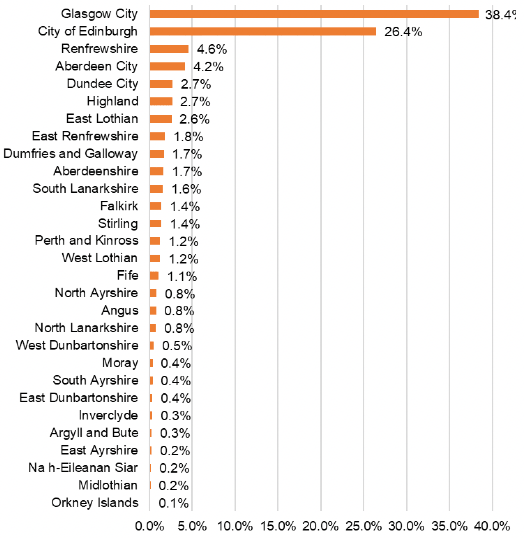
Source: Creative Scotland - data as at 5th Nov 2020
Tour Operators Fund (inc. international inbound and larger domestic operators)[104]
- What is it? The £15 million fund was delivered by VisitScotland on behalf of the Scottish Government to help businesses in the tourism and hospitality sector to survive the impacts of the Covid-19 pandemic. A two-strand approach to grant funding was delivered to support this sector:
- (a) Scotland Inbound Tour Operators - COVID-19 Business Support and Continuity Fund - specifically support Scottish based businesses in the International Inbound tour operator sector that are facing hardship. Grant award calculated by businesses' revenue and capped at £700,000 per business.
- (b) Scotland Day Tour Operators - COVID-19 Business Support and Continuity Fund - specifically support Scottish based businesses in the day and multi-day tour operator sector that are facing hardship. Grant award calculated by businesses' turnover and capped at £40,000 per business.
- Value: £14.2 million
- Take-up: 189 businesses
- Status: Inbound scheme closed 18th March 2021 and Day Tour scheme closed 11th March 2021.
189 awards have been paid through the same out of 278 applications, an award rate of 68%. A total of £14,200,000 has been paid out through the scheme to date with an average award value of £75,132.
Pivotal Event Businesses Fund[105]
- What is it? Fund delivered by VisitScotland on behalf of the Scottish Government and was developed in consultation with the Event Industry Advisory Group. The fund was open to event businesses whose primary role as organisers, suppliers, contractors and venues is critical to the survival of the events sector in Scotland, and upon whom the wider events industry and supply chain are most reliant for their own business and operations. Funding was prioritised towards those businesses that could evidence and demonstrate that they play a pivotal role across the events industry in Scotland and are in financial difficulty as a direct result of COVID-19. Applicants could apply for grants from £25,000 up to a maximum £150,000.
- Value: £11.1 million
- Take-up: 103 businesses
- Status: Closed 22nd December 2020.
103 awards have been paid through the same out of 129 applications, an award rate of 80%. A total of £11,100,000 has been paid out through the scheme to date with an average value of £107,767 awarded.
Scottish Government Performing Arts Venues Relief Fund[106]
- What is it? Fund is to provide performing arts venues in Scotland with emergency funding that will allow them to remain solvent, will support the return of staff from furlough, and will provide support for new artistic commissions from freelance artists. Delivered through Creative Scotland.
- Value: £12.2 million
- Take-up: 79 awards
- Status: Closed in 2020.
79 awards have been paid has been paid out through the scheme to date, a total value of £12,200,000. The average value of grant awarded was £154,430.
£7.5 million was awarded to 20 venues through the first round of the scheme and a further 59 venues received £4.74 million through the second round (note that venues could receive funding from both rounds). The amount awarded ranged from £20,000 to £750,000 across the two rounds. The largest award of £750,000 went to three venues respectively; Aberdeen Performing Arts, Eden Court Theatre and Cinema, and the Royal Lyceum Theatre Company.
By local authority, City of Edinburgh (16% of total awards and 22% of value) and Glasgow City (both 15%) received the greatest share of awards and value awarded. Renfrewshire received the smallest share of funding accounting for 2% of awards and 1% of funding.
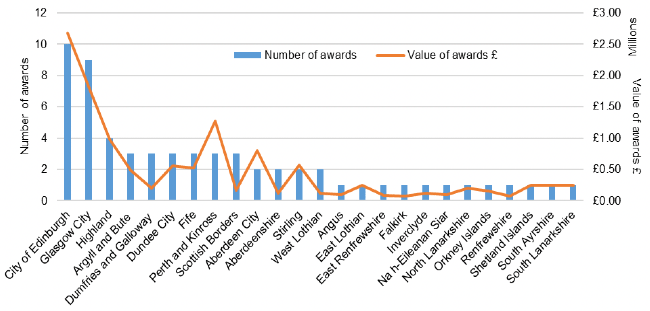
Source: Creative Scotland
Scottish Wholesale Food and Drink Resilience Fund[107]
- What is it? Fund provided grants to Scottish food and drink wholesalers suffering hardship as a result of the coronavirus pandemic. The level of grant varied depending on the business and the application.
- Value: £5.5 million
- Take-up: 41 businesses
- Status: Closed December 13 2020.
41 awards have been paid through the same out of 113 applications, an award rate of 36%. A total of £5,527,019 has been paid out through the scheme to date. The average value of grant awarded was £134,146.
The grants awarded ranged from approx. £5,000 to £500,000. The largest grants awarded were £500,000 respectively to five companies in Scotland: William Morton Ltd t/a Inverarity Morton, Allson (Sparkle) Ltd t/a Allson Wholesale, Dunns Food & Drinks Ltd, Braehead Foods, and JB Foods (Scotland) Ltd. You can find grants awarded by company here: Coronavirus (COVID-19): Scottish Wholesale Food and Drink Resilience Fund - gov.scot (www.gov.scot).
By local authority, the greatest share of awards and funding went to Glasgow (22% of total awards and 21% of value). Scottish Borders received the smallest share of funding (2% of total awards and 0.3% of value).
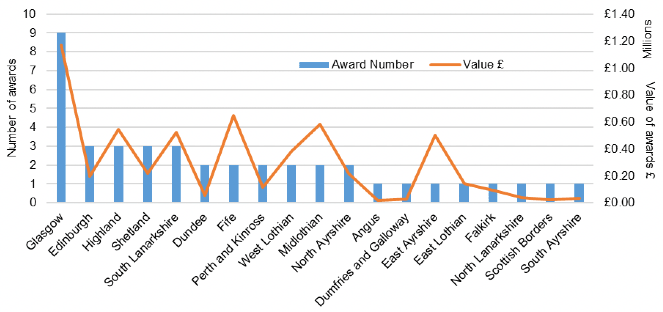
Source: Scottish Government
Fisheries and Seafood Support Funds
968 applications awarded and £14.2 million paid out across the two funds.
(a) Sea Fisheries Intervention Fund[108]
- What is it? Emergency hardship grant support for fishing vessels impacted by the COVID-19 outbreak. For those eligible, an initial payment of 50% of two months' average vessel earnings is made (grant capped at a maximum of £27,000).
- Value: £8.4m paid out in total.
- Take-up: 836 fishing vessels supported.
- Status: Scheme closed beginning of June 2020.
836 awards have been paid through the same out of 867 applications, an award rate of 96%. A total of £8,400,000 was paid out through the scheme. The average value of grant awarded was £10,048.
The following data is at 8th June 2020:
There were 606 successful applications for the under 12 metres vessels support, worth £4.9 million. The application success rate was 96%. The average (mean) amount awarded was £8,085.81. There were 195 successful applications for the over 12 metres vessels support, worth £3.2 million. The average (mean) amount awarded was £16,410.26.
The award rate was high for both types of vessels: 98.9% for under 12 metres vessels and 98.5% for over 12 metres vessels.
(b) Scottish Seafood Business Resilience Fund[109]
- What is it? Grant support for seafood processing businesses encountering severe hardship as a consequence of the COVID-19 pandemic and resulting collapse of export markets.
- Value: £5.8m paid out (up to £10m available)
- Take up: 132 businesses paid.
- Status: Scheme now closed.
The Fund provided over £5.8 million in grant funding to 132 businesses, reaching virtually all of the 130-140 seafood processing businesses in Scotland. The average (mean) amount paid was £44,124.61.
Creative Scotland and Screen Scotland Bridging Bursary Funds[110]
- What is it? Grant support between £500 and £2,500 to help sustain freelance creative professionals or self-employed screen practitioners who have lost earnings due to the cancelation of work as a result of COVID-19.
- Value: £4.3m paid out (Available: £3m Creative Scotland Bridging Bursary Fund and £1.5m Screen Scotland Bridging Bursary Fund)
- Take up: 2,293 freelancers have been paid grants.
- Status: Schemes now closed.
Across the two funds, 2,831 applications had been received across Scotland, with 2,293 grants awarded with a total value of £4.3 million, an award rate of 81%. The average (mean) amount awarded was £1,876.
In terms of Creative Scotland Bridging Bursary Fund, Glasgow City (41%) and City of Edinburgh (22%) accounted for almost two thirds of the total value awarded. North Lanarkshire (50%) saw the lowest award rate. The award rate for freelancers in LAs classed as rural (80%) was broadly in line with freelancers in LAs classed as urban (82%). By art form, Music (30%) accounted for the greatest proportion of grants awarded by value, followed by visual Arts (25%). Visual Arts had the highest award rate (92%) whereas Digital (35%) and Other art forms (17%) saw the lowest award rates.
In terms of the Screen Scotland Bridging Bursary Fund, Glasgow City (49%) accounted for half of value awarded. The award rate was higher for freelancers in LAs classed as urban (82%) than for those in LAs classed as rural (77%). By art form, TV Development or Production (29%) and TV (28%) accounted for the greatest proportion of grants awarded by value. Screen Education has the highest award rate at 88% while Exhibition had the lowest at 50%.
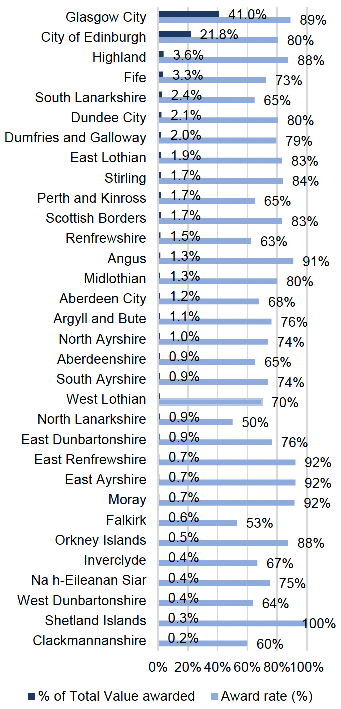
Source: Creative Scotland
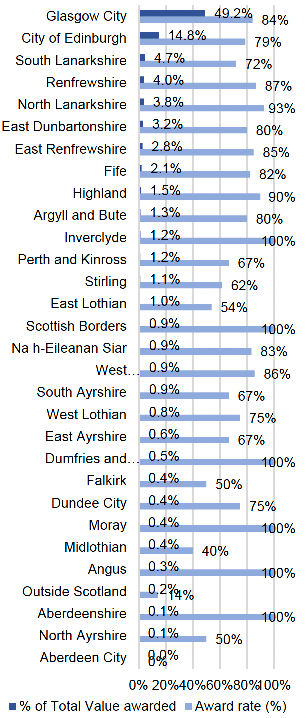
Source: Screen Scotland
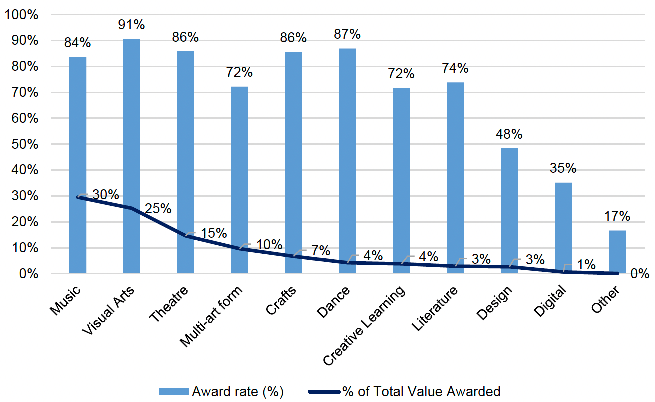
Source: Creative Scotland
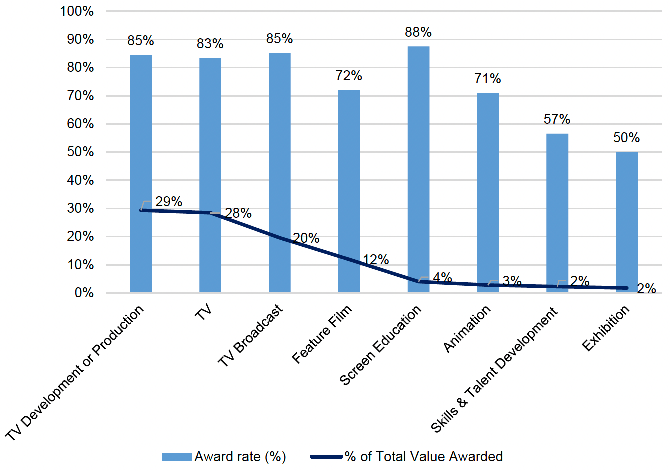
Source: Screen Scotland
Contact
Email: caroline.macfarlane@gov.scot
There is a problem
Thanks for your feedback